BSBMKG608 Develop Organisational Marketing Objectives Assessment Resource Summary
VerifiedAdded on 2023/06/11
|32
|8517
|232
AI Summary
This unit describes the skills and knowledge required to conduct a strategic analysis to develop organisational marketing objectives. This involves reviewing the organisation’s internal and external environments, evaluating past and current marketing performance, and exploring and evaluating new marketing opportunities.
Contribute Materials
Your contribution can guide someone’s learning journey. Share your
documents today.
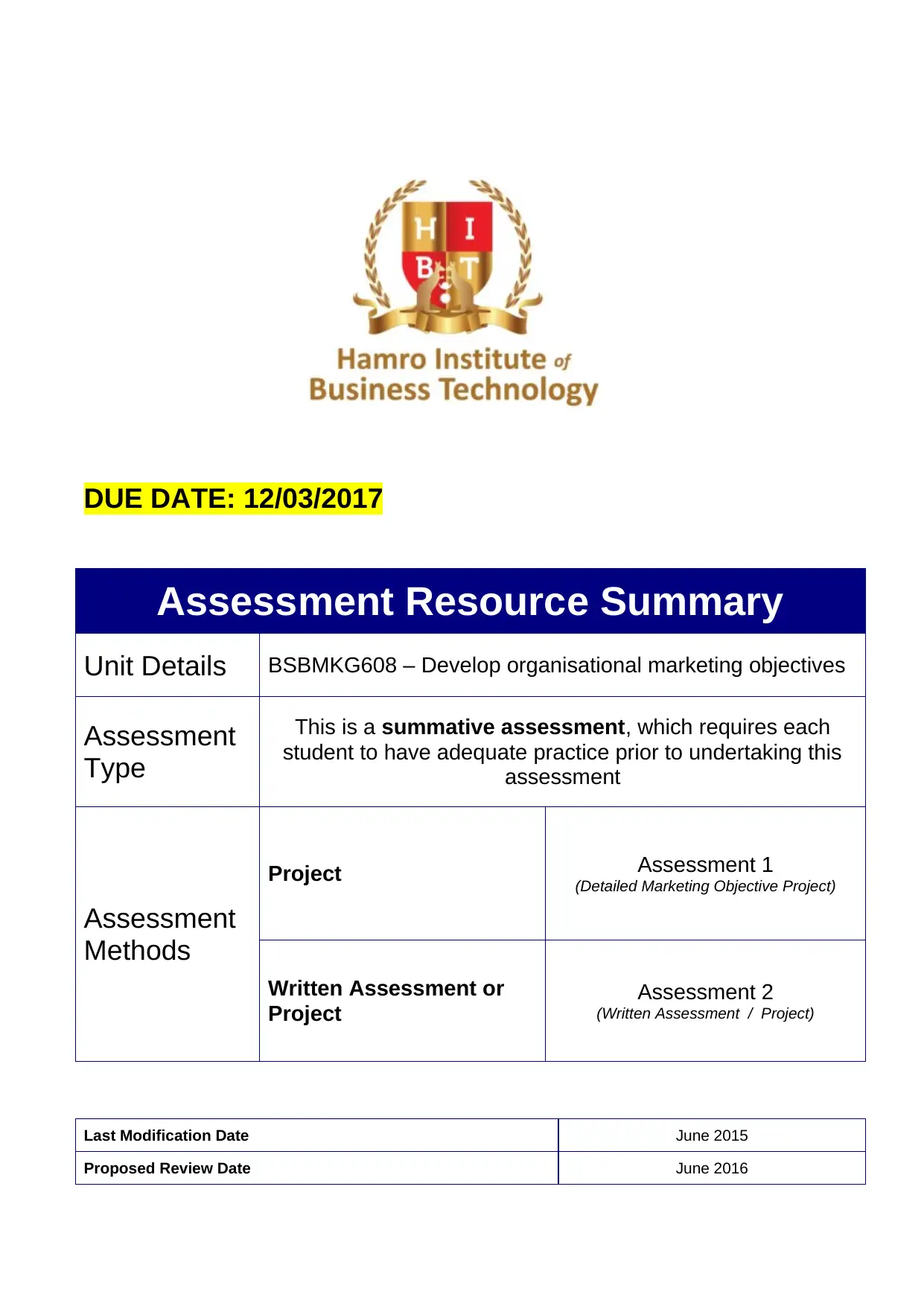
DUE DATE: 12/03/2017
Assessment Resource Summary
Unit Details BSBMKG608 – Develop organisational marketing objectives
Assessment
Type
This is a summative assessment, which requires each
student to have adequate practice prior to undertaking this
assessment
Assessment
Methods
Project Assessment 1
(Detailed Marketing Objective Project)
Written Assessment or
Project Assessment 2
(Written Assessment / Project)
Last Modification Date June 2015
Proposed Review Date June 2016
Assessment Resource Summary
Unit Details BSBMKG608 – Develop organisational marketing objectives
Assessment
Type
This is a summative assessment, which requires each
student to have adequate practice prior to undertaking this
assessment
Assessment
Methods
Project Assessment 1
(Detailed Marketing Objective Project)
Written Assessment or
Project Assessment 2
(Written Assessment / Project)
Last Modification Date June 2015
Proposed Review Date June 2016
Secure Best Marks with AI Grader
Need help grading? Try our AI Grader for instant feedback on your assignments.
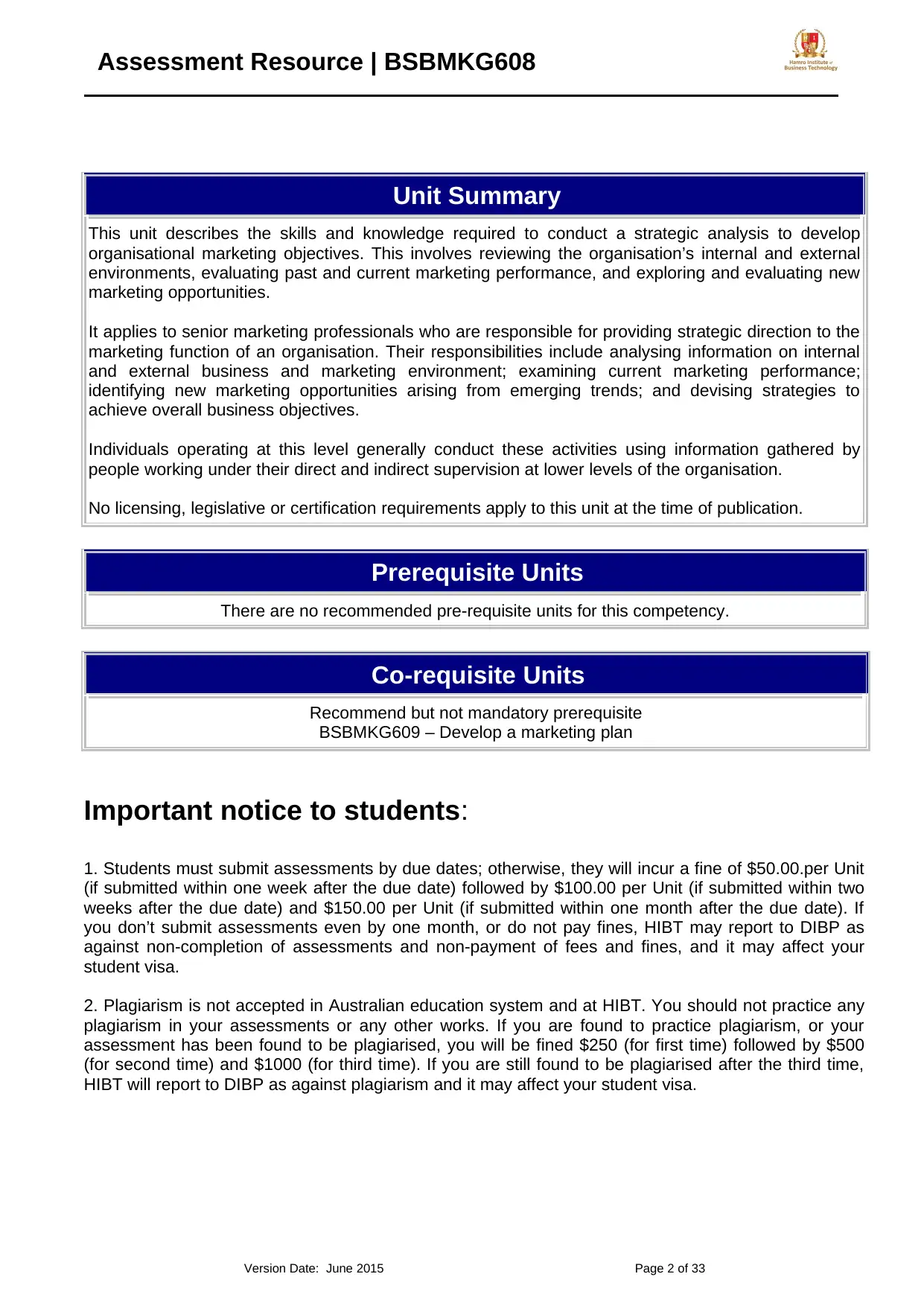
Assessment Resource | BSBMKG608
Unit Summary
This unit describes the skills and knowledge required to conduct a strategic analysis to develop
organisational marketing objectives. This involves reviewing the organisation’s internal and external
environments, evaluating past and current marketing performance, and exploring and evaluating new
marketing opportunities.
It applies to senior marketing professionals who are responsible for providing strategic direction to the
marketing function of an organisation. Their responsibilities include analysing information on internal
and external business and marketing environment; examining current marketing performance;
identifying new marketing opportunities arising from emerging trends; and devising strategies to
achieve overall business objectives.
Individuals operating at this level generally conduct these activities using information gathered by
people working under their direct and indirect supervision at lower levels of the organisation.
No licensing, legislative or certification requirements apply to this unit at the time of publication.
Prerequisite Units
There are no recommended pre-requisite units for this competency.
Co-requisite Units
Recommend but not mandatory prerequisite
BSBMKG609 – Develop a marketing plan
Important notice to students:
1. Students must submit assessments by due dates; otherwise, they will incur a fine of $50.00.per Unit
(if submitted within one week after the due date) followed by $100.00 per Unit (if submitted within two
weeks after the due date) and $150.00 per Unit (if submitted within one month after the due date). If
you don’t submit assessments even by one month, or do not pay fines, HIBT may report to DIBP as
against non-completion of assessments and non-payment of fees and fines, and it may affect your
student visa.
2. Plagiarism is not accepted in Australian education system and at HIBT. You should not practice any
plagiarism in your assessments or any other works. If you are found to practice plagiarism, or your
assessment has been found to be plagiarised, you will be fined $250 (for first time) followed by $500
(for second time) and $1000 (for third time). If you are still found to be plagiarised after the third time,
HIBT will report to DIBP as against plagiarism and it may affect your student visa.
Version Date: June 2015 Page 2 of 33
Unit Summary
This unit describes the skills and knowledge required to conduct a strategic analysis to develop
organisational marketing objectives. This involves reviewing the organisation’s internal and external
environments, evaluating past and current marketing performance, and exploring and evaluating new
marketing opportunities.
It applies to senior marketing professionals who are responsible for providing strategic direction to the
marketing function of an organisation. Their responsibilities include analysing information on internal
and external business and marketing environment; examining current marketing performance;
identifying new marketing opportunities arising from emerging trends; and devising strategies to
achieve overall business objectives.
Individuals operating at this level generally conduct these activities using information gathered by
people working under their direct and indirect supervision at lower levels of the organisation.
No licensing, legislative or certification requirements apply to this unit at the time of publication.
Prerequisite Units
There are no recommended pre-requisite units for this competency.
Co-requisite Units
Recommend but not mandatory prerequisite
BSBMKG609 – Develop a marketing plan
Important notice to students:
1. Students must submit assessments by due dates; otherwise, they will incur a fine of $50.00.per Unit
(if submitted within one week after the due date) followed by $100.00 per Unit (if submitted within two
weeks after the due date) and $150.00 per Unit (if submitted within one month after the due date). If
you don’t submit assessments even by one month, or do not pay fines, HIBT may report to DIBP as
against non-completion of assessments and non-payment of fees and fines, and it may affect your
student visa.
2. Plagiarism is not accepted in Australian education system and at HIBT. You should not practice any
plagiarism in your assessments or any other works. If you are found to practice plagiarism, or your
assessment has been found to be plagiarised, you will be fined $250 (for first time) followed by $500
(for second time) and $1000 (for third time). If you are still found to be plagiarised after the third time,
HIBT will report to DIBP as against plagiarism and it may affect your student visa.
Version Date: June 2015 Page 2 of 33
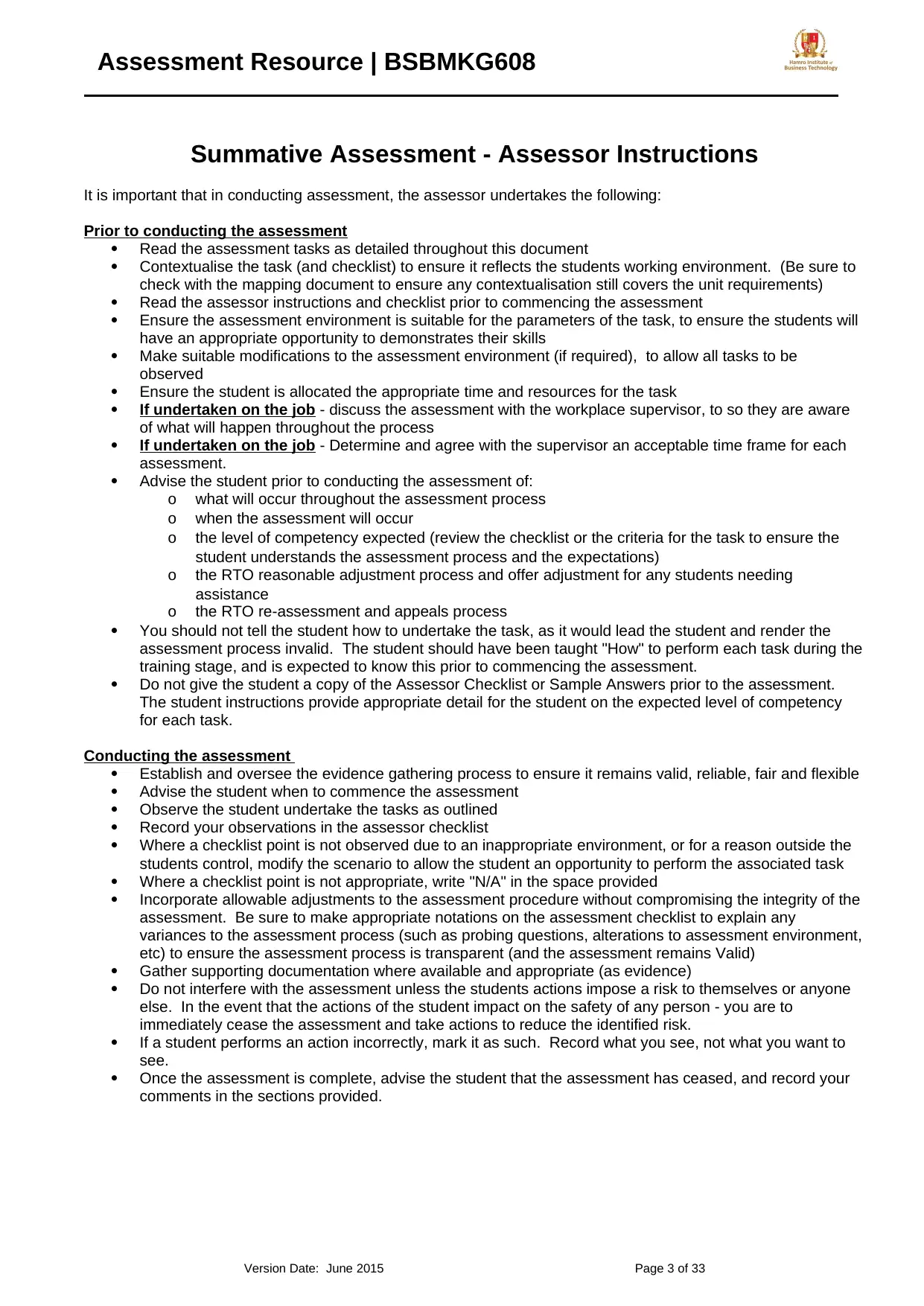
Assessment Resource | BSBMKG608
Summative Assessment - Assessor Instructions
It is important that in conducting assessment, the assessor undertakes the following:
Prior to conducting the assessment
Read the assessment tasks as detailed throughout this document
Contextualise the task (and checklist) to ensure it reflects the students working environment. (Be sure to
check with the mapping document to ensure any contextualisation still covers the unit requirements)
Read the assessor instructions and checklist prior to commencing the assessment
Ensure the assessment environment is suitable for the parameters of the task, to ensure the students will
have an appropriate opportunity to demonstrates their skills
Make suitable modifications to the assessment environment (if required), to allow all tasks to be
observed
Ensure the student is allocated the appropriate time and resources for the task
If undertaken on the job - discuss the assessment with the workplace supervisor, to so they are aware
of what will happen throughout the process
If undertaken on the job - Determine and agree with the supervisor an acceptable time frame for each
assessment.
Advise the student prior to conducting the assessment of:
o what will occur throughout the assessment process
o when the assessment will occur
o the level of competency expected (review the checklist or the criteria for the task to ensure the
student understands the assessment process and the expectations)
o the RTO reasonable adjustment process and offer adjustment for any students needing
assistance
o the RTO re-assessment and appeals process
You should not tell the student how to undertake the task, as it would lead the student and render the
assessment process invalid. The student should have been taught "How" to perform each task during the
training stage, and is expected to know this prior to commencing the assessment.
Do not give the student a copy of the Assessor Checklist or Sample Answers prior to the assessment.
The student instructions provide appropriate detail for the student on the expected level of competency
for each task.
Conducting the assessment
Establish and oversee the evidence gathering process to ensure it remains valid, reliable, fair and flexible
Advise the student when to commence the assessment
Observe the student undertake the tasks as outlined
Record your observations in the assessor checklist
Where a checklist point is not observed due to an inappropriate environment, or for a reason outside the
students control, modify the scenario to allow the student an opportunity to perform the associated task
Where a checklist point is not appropriate, write "N/A" in the space provided
Incorporate allowable adjustments to the assessment procedure without compromising the integrity of the
assessment. Be sure to make appropriate notations on the assessment checklist to explain any
variances to the assessment process (such as probing questions, alterations to assessment environment,
etc) to ensure the assessment process is transparent (and the assessment remains Valid)
Gather supporting documentation where available and appropriate (as evidence)
Do not interfere with the assessment unless the students actions impose a risk to themselves or anyone
else. In the event that the actions of the student impact on the safety of any person - you are to
immediately cease the assessment and take actions to reduce the identified risk.
If a student performs an action incorrectly, mark it as such. Record what you see, not what you want to
see.
Once the assessment is complete, advise the student that the assessment has ceased, and record your
comments in the sections provided.
Version Date: June 2015 Page 3 of 33
Summative Assessment - Assessor Instructions
It is important that in conducting assessment, the assessor undertakes the following:
Prior to conducting the assessment
Read the assessment tasks as detailed throughout this document
Contextualise the task (and checklist) to ensure it reflects the students working environment. (Be sure to
check with the mapping document to ensure any contextualisation still covers the unit requirements)
Read the assessor instructions and checklist prior to commencing the assessment
Ensure the assessment environment is suitable for the parameters of the task, to ensure the students will
have an appropriate opportunity to demonstrates their skills
Make suitable modifications to the assessment environment (if required), to allow all tasks to be
observed
Ensure the student is allocated the appropriate time and resources for the task
If undertaken on the job - discuss the assessment with the workplace supervisor, to so they are aware
of what will happen throughout the process
If undertaken on the job - Determine and agree with the supervisor an acceptable time frame for each
assessment.
Advise the student prior to conducting the assessment of:
o what will occur throughout the assessment process
o when the assessment will occur
o the level of competency expected (review the checklist or the criteria for the task to ensure the
student understands the assessment process and the expectations)
o the RTO reasonable adjustment process and offer adjustment for any students needing
assistance
o the RTO re-assessment and appeals process
You should not tell the student how to undertake the task, as it would lead the student and render the
assessment process invalid. The student should have been taught "How" to perform each task during the
training stage, and is expected to know this prior to commencing the assessment.
Do not give the student a copy of the Assessor Checklist or Sample Answers prior to the assessment.
The student instructions provide appropriate detail for the student on the expected level of competency
for each task.
Conducting the assessment
Establish and oversee the evidence gathering process to ensure it remains valid, reliable, fair and flexible
Advise the student when to commence the assessment
Observe the student undertake the tasks as outlined
Record your observations in the assessor checklist
Where a checklist point is not observed due to an inappropriate environment, or for a reason outside the
students control, modify the scenario to allow the student an opportunity to perform the associated task
Where a checklist point is not appropriate, write "N/A" in the space provided
Incorporate allowable adjustments to the assessment procedure without compromising the integrity of the
assessment. Be sure to make appropriate notations on the assessment checklist to explain any
variances to the assessment process (such as probing questions, alterations to assessment environment,
etc) to ensure the assessment process is transparent (and the assessment remains Valid)
Gather supporting documentation where available and appropriate (as evidence)
Do not interfere with the assessment unless the students actions impose a risk to themselves or anyone
else. In the event that the actions of the student impact on the safety of any person - you are to
immediately cease the assessment and take actions to reduce the identified risk.
If a student performs an action incorrectly, mark it as such. Record what you see, not what you want to
see.
Once the assessment is complete, advise the student that the assessment has ceased, and record your
comments in the sections provided.
Version Date: June 2015 Page 3 of 33
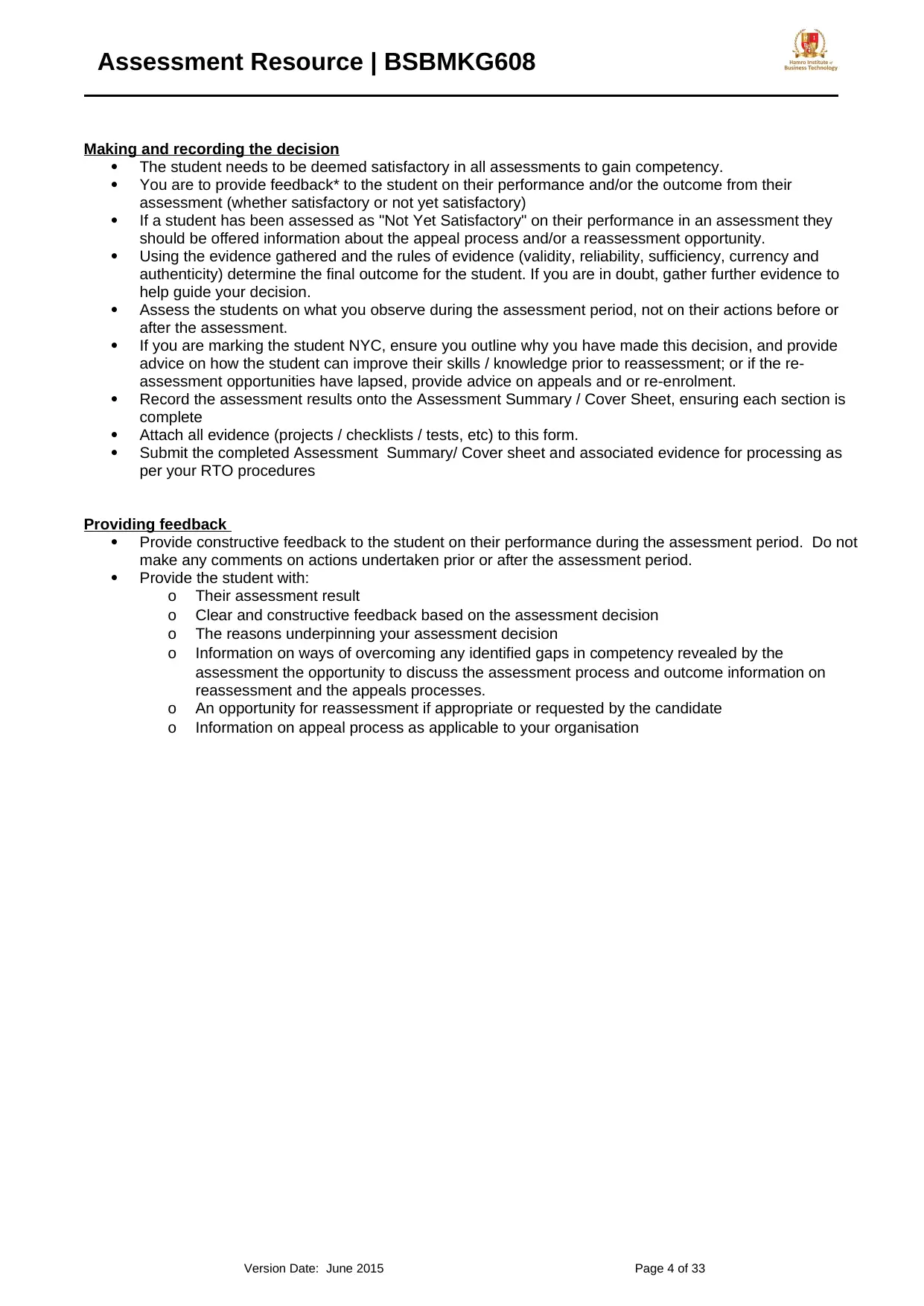
Assessment Resource | BSBMKG608
Making and recording the decision
The student needs to be deemed satisfactory in all assessments to gain competency.
You are to provide feedback* to the student on their performance and/or the outcome from their
assessment (whether satisfactory or not yet satisfactory)
If a student has been assessed as "Not Yet Satisfactory" on their performance in an assessment they
should be offered information about the appeal process and/or a reassessment opportunity.
Using the evidence gathered and the rules of evidence (validity, reliability, sufficiency, currency and
authenticity) determine the final outcome for the student. If you are in doubt, gather further evidence to
help guide your decision.
Assess the students on what you observe during the assessment period, not on their actions before or
after the assessment.
If you are marking the student NYC, ensure you outline why you have made this decision, and provide
advice on how the student can improve their skills / knowledge prior to reassessment; or if the re-
assessment opportunities have lapsed, provide advice on appeals and or re-enrolment.
Record the assessment results onto the Assessment Summary / Cover Sheet, ensuring each section is
complete
Attach all evidence (projects / checklists / tests, etc) to this form.
Submit the completed Assessment Summary/ Cover sheet and associated evidence for processing as
per your RTO procedures
Providing feedback
Provide constructive feedback to the student on their performance during the assessment period. Do not
make any comments on actions undertaken prior or after the assessment period.
Provide the student with:
o Their assessment result
o Clear and constructive feedback based on the assessment decision
o The reasons underpinning your assessment decision
o Information on ways of overcoming any identified gaps in competency revealed by the
assessment the opportunity to discuss the assessment process and outcome information on
reassessment and the appeals processes.
o An opportunity for reassessment if appropriate or requested by the candidate
o Information on appeal process as applicable to your organisation
Version Date: June 2015 Page 4 of 33
Making and recording the decision
The student needs to be deemed satisfactory in all assessments to gain competency.
You are to provide feedback* to the student on their performance and/or the outcome from their
assessment (whether satisfactory or not yet satisfactory)
If a student has been assessed as "Not Yet Satisfactory" on their performance in an assessment they
should be offered information about the appeal process and/or a reassessment opportunity.
Using the evidence gathered and the rules of evidence (validity, reliability, sufficiency, currency and
authenticity) determine the final outcome for the student. If you are in doubt, gather further evidence to
help guide your decision.
Assess the students on what you observe during the assessment period, not on their actions before or
after the assessment.
If you are marking the student NYC, ensure you outline why you have made this decision, and provide
advice on how the student can improve their skills / knowledge prior to reassessment; or if the re-
assessment opportunities have lapsed, provide advice on appeals and or re-enrolment.
Record the assessment results onto the Assessment Summary / Cover Sheet, ensuring each section is
complete
Attach all evidence (projects / checklists / tests, etc) to this form.
Submit the completed Assessment Summary/ Cover sheet and associated evidence for processing as
per your RTO procedures
Providing feedback
Provide constructive feedback to the student on their performance during the assessment period. Do not
make any comments on actions undertaken prior or after the assessment period.
Provide the student with:
o Their assessment result
o Clear and constructive feedback based on the assessment decision
o The reasons underpinning your assessment decision
o Information on ways of overcoming any identified gaps in competency revealed by the
assessment the opportunity to discuss the assessment process and outcome information on
reassessment and the appeals processes.
o An opportunity for reassessment if appropriate or requested by the candidate
o Information on appeal process as applicable to your organisation
Version Date: June 2015 Page 4 of 33
Secure Best Marks with AI Grader
Need help grading? Try our AI Grader for instant feedback on your assignments.
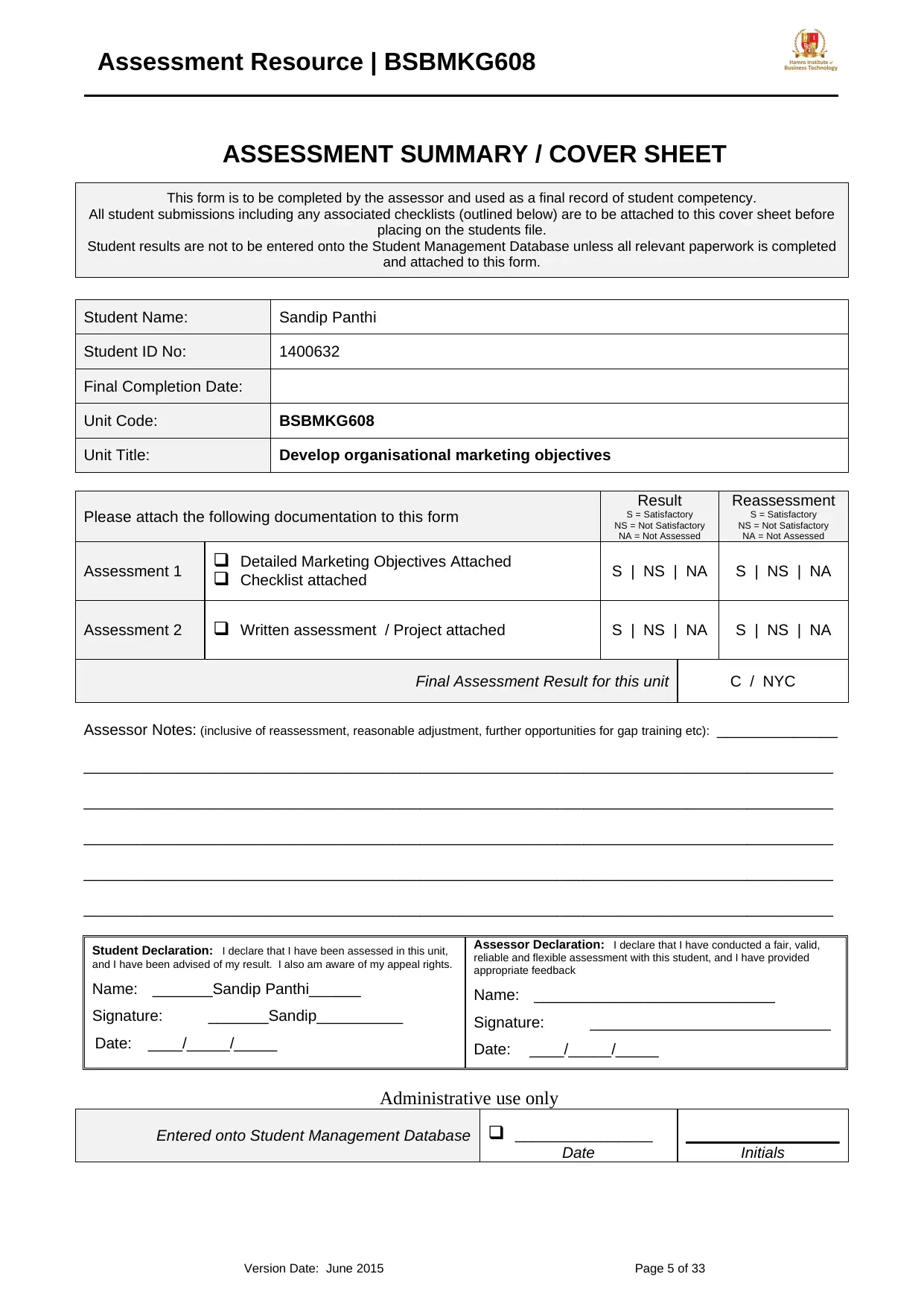
Assessment Resource | BSBMKG608
ASSESSMENT SUMMARY / COVER SHEET
This form is to be completed by the assessor and used as a final record of student competency.
All student submissions including any associated checklists (outlined below) are to be attached to this cover sheet before
placing on the students file.
Student results are not to be entered onto the Student Management Database unless all relevant paperwork is completed
and attached to this form.
Student Name: Sandip Panthi
Student ID No: 1400632
Final Completion Date:
Unit Code: BSBMKG608
Unit Title: Develop organisational marketing objectives
Please attach the following documentation to this form
Result
S = Satisfactory
NS = Not Satisfactory
NA = Not Assessed
Reassessment
S = Satisfactory
NS = Not Satisfactory
NA = Not Assessed
Assessment 1 Detailed Marketing Objectives Attached
Checklist attached S | NS | NA S | NS | NA
Assessment 2 Written assessment / Project attached S | NS | NA S | NS | NA
Final Assessment Result for this unit C / NYC
Assessor Notes: (inclusive of reassessment, reasonable adjustment, further opportunities for gap training etc): ______________
_______________________________________________________________________________________
_______________________________________________________________________________________
_______________________________________________________________________________________
_______________________________________________________________________________________
_______________________________________________________________________________________
Student Declaration: I declare that I have been assessed in this unit,
and I have been advised of my result. I also am aware of my appeal rights.
Name: _______Sandip Panthi______
Signature: _______Sandip__________
Date: ____/_____/_____
Assessor Declaration: I declare that I have conducted a fair, valid,
reliable and flexible assessment with this student, and I have provided
appropriate feedback
Name: ____________________________
Signature: ____________________________
Date: ____/_____/_____
Administrative use only
Entered onto Student Management Database ________________
Date Initials
Version Date: June 2015 Page 5 of 33
ASSESSMENT SUMMARY / COVER SHEET
This form is to be completed by the assessor and used as a final record of student competency.
All student submissions including any associated checklists (outlined below) are to be attached to this cover sheet before
placing on the students file.
Student results are not to be entered onto the Student Management Database unless all relevant paperwork is completed
and attached to this form.
Student Name: Sandip Panthi
Student ID No: 1400632
Final Completion Date:
Unit Code: BSBMKG608
Unit Title: Develop organisational marketing objectives
Please attach the following documentation to this form
Result
S = Satisfactory
NS = Not Satisfactory
NA = Not Assessed
Reassessment
S = Satisfactory
NS = Not Satisfactory
NA = Not Assessed
Assessment 1 Detailed Marketing Objectives Attached
Checklist attached S | NS | NA S | NS | NA
Assessment 2 Written assessment / Project attached S | NS | NA S | NS | NA
Final Assessment Result for this unit C / NYC
Assessor Notes: (inclusive of reassessment, reasonable adjustment, further opportunities for gap training etc): ______________
_______________________________________________________________________________________
_______________________________________________________________________________________
_______________________________________________________________________________________
_______________________________________________________________________________________
_______________________________________________________________________________________
Student Declaration: I declare that I have been assessed in this unit,
and I have been advised of my result. I also am aware of my appeal rights.
Name: _______Sandip Panthi______
Signature: _______Sandip__________
Date: ____/_____/_____
Assessor Declaration: I declare that I have conducted a fair, valid,
reliable and flexible assessment with this student, and I have provided
appropriate feedback
Name: ____________________________
Signature: ____________________________
Date: ____/_____/_____
Administrative use only
Entered onto Student Management Database ________________
Date Initials
Version Date: June 2015 Page 5 of 33
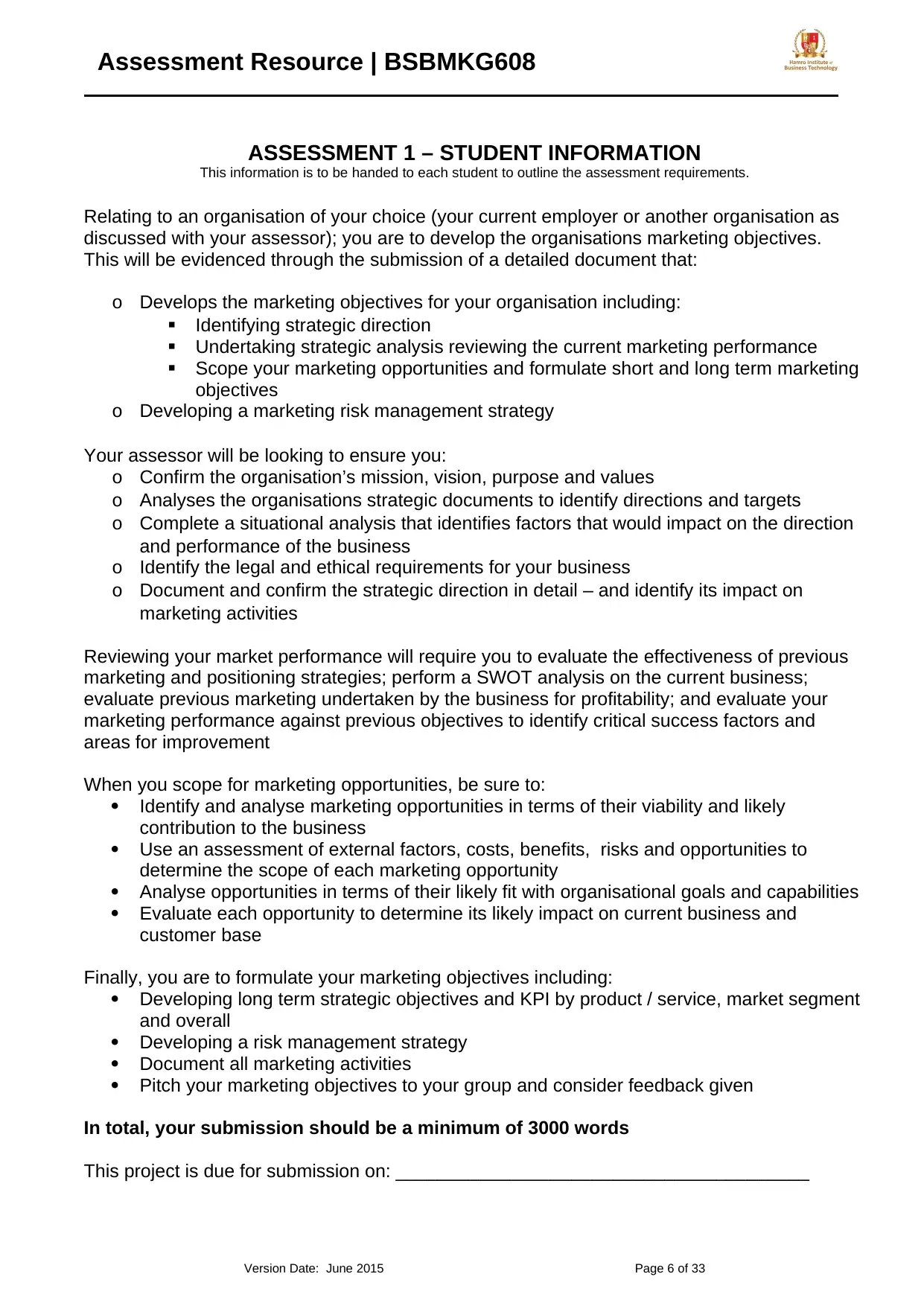
Assessment Resource | BSBMKG608
ASSESSMENT 1 – STUDENT INFORMATION
This information is to be handed to each student to outline the assessment requirements.
Relating to an organisation of your choice (your current employer or another organisation as
discussed with your assessor); you are to develop the organisations marketing objectives.
This will be evidenced through the submission of a detailed document that:
o Develops the marketing objectives for your organisation including:
Identifying strategic direction
Undertaking strategic analysis reviewing the current marketing performance
Scope your marketing opportunities and formulate short and long term marketing
objectives
o Developing a marketing risk management strategy
Your assessor will be looking to ensure you:
o Confirm the organisation’s mission, vision, purpose and values
o Analyses the organisations strategic documents to identify directions and targets
o Complete a situational analysis that identifies factors that would impact on the direction
and performance of the business
o Identify the legal and ethical requirements for your business
o Document and confirm the strategic direction in detail – and identify its impact on
marketing activities
Reviewing your market performance will require you to evaluate the effectiveness of previous
marketing and positioning strategies; perform a SWOT analysis on the current business;
evaluate previous marketing undertaken by the business for profitability; and evaluate your
marketing performance against previous objectives to identify critical success factors and
areas for improvement
When you scope for marketing opportunities, be sure to:
Identify and analyse marketing opportunities in terms of their viability and likely
contribution to the business
Use an assessment of external factors, costs, benefits, risks and opportunities to
determine the scope of each marketing opportunity
Analyse opportunities in terms of their likely fit with organisational goals and capabilities
Evaluate each opportunity to determine its likely impact on current business and
customer base
Finally, you are to formulate your marketing objectives including:
Developing long term strategic objectives and KPI by product / service, market segment
and overall
Developing a risk management strategy
Document all marketing activities
Pitch your marketing objectives to your group and consider feedback given
In total, your submission should be a minimum of 3000 words
This project is due for submission on: ________________________________________
Version Date: June 2015 Page 6 of 33
ASSESSMENT 1 – STUDENT INFORMATION
This information is to be handed to each student to outline the assessment requirements.
Relating to an organisation of your choice (your current employer or another organisation as
discussed with your assessor); you are to develop the organisations marketing objectives.
This will be evidenced through the submission of a detailed document that:
o Develops the marketing objectives for your organisation including:
Identifying strategic direction
Undertaking strategic analysis reviewing the current marketing performance
Scope your marketing opportunities and formulate short and long term marketing
objectives
o Developing a marketing risk management strategy
Your assessor will be looking to ensure you:
o Confirm the organisation’s mission, vision, purpose and values
o Analyses the organisations strategic documents to identify directions and targets
o Complete a situational analysis that identifies factors that would impact on the direction
and performance of the business
o Identify the legal and ethical requirements for your business
o Document and confirm the strategic direction in detail – and identify its impact on
marketing activities
Reviewing your market performance will require you to evaluate the effectiveness of previous
marketing and positioning strategies; perform a SWOT analysis on the current business;
evaluate previous marketing undertaken by the business for profitability; and evaluate your
marketing performance against previous objectives to identify critical success factors and
areas for improvement
When you scope for marketing opportunities, be sure to:
Identify and analyse marketing opportunities in terms of their viability and likely
contribution to the business
Use an assessment of external factors, costs, benefits, risks and opportunities to
determine the scope of each marketing opportunity
Analyse opportunities in terms of their likely fit with organisational goals and capabilities
Evaluate each opportunity to determine its likely impact on current business and
customer base
Finally, you are to formulate your marketing objectives including:
Developing long term strategic objectives and KPI by product / service, market segment
and overall
Developing a risk management strategy
Document all marketing activities
Pitch your marketing objectives to your group and consider feedback given
In total, your submission should be a minimum of 3000 words
This project is due for submission on: ________________________________________
Version Date: June 2015 Page 6 of 33

Assessment Resource | BSBMKG608
ASSESSMENT 1 – STUDENT SELF ASSESSMENT CHECKLIST
This information is to be handed to each student to outline the assessment criteria
This checklist is similar to the one being used by your assessor during this assessment. This checklist should
be reviewed by you to evaluate your readiness for assessment, and to confirm your understanding of the
criteria by which this assessment task will be judged.
Once you feel you have the required skills and knowledge to demonstrate each of the following assessment
criteria, you are ready to be assessed. Please speak with your assessor if you feel you are not ready to be
assessed before the assessment has commenced.
You may refer to this checklist at any stage PRIOR to the commencement of your assessment. You may not
refer to this checklist whilst you are being assessed.
Student Assessment Criteria I feel I can
demonstrate this
Communication | Are you able to:
o Communicate clearly with others
o Clarity the task requirements
o Ask for help when needed
o Follow instructions
o Give and receive feedback as appropriate
o Answer questions and clarify concerns that arise
o Explain rational on decisions effectively
Yes No
Safety | Are you able to:
o Work safely at all times Yes No
o Ensure your actions do not put the safety of yourself or others at risk Yes No
Task requirements | Are you able to:
o Identify / confirm the organisation’s mission (1 - 2 sentences) Yes No
o Identify / confirm the organisation’s vision (1- 3 paragraph) Yes No
o Research the organisations purpose and value from either internal materials,
owners, directors or senior management Yes No
o Identify the organisational directions Yes No
o Identify the organisations targets Yes No
o Undertake a situational analysis that includes
o collaborators analysis
o competitive analysis
o environmental analysis
o market analysis
o market measurements
o productivity or profitability analysis
Yes No
Version Date: June 2015 Page 7 of 33
ASSESSMENT 1 – STUDENT SELF ASSESSMENT CHECKLIST
This information is to be handed to each student to outline the assessment criteria
This checklist is similar to the one being used by your assessor during this assessment. This checklist should
be reviewed by you to evaluate your readiness for assessment, and to confirm your understanding of the
criteria by which this assessment task will be judged.
Once you feel you have the required skills and knowledge to demonstrate each of the following assessment
criteria, you are ready to be assessed. Please speak with your assessor if you feel you are not ready to be
assessed before the assessment has commenced.
You may refer to this checklist at any stage PRIOR to the commencement of your assessment. You may not
refer to this checklist whilst you are being assessed.
Student Assessment Criteria I feel I can
demonstrate this
Communication | Are you able to:
o Communicate clearly with others
o Clarity the task requirements
o Ask for help when needed
o Follow instructions
o Give and receive feedback as appropriate
o Answer questions and clarify concerns that arise
o Explain rational on decisions effectively
Yes No
Safety | Are you able to:
o Work safely at all times Yes No
o Ensure your actions do not put the safety of yourself or others at risk Yes No
Task requirements | Are you able to:
o Identify / confirm the organisation’s mission (1 - 2 sentences) Yes No
o Identify / confirm the organisation’s vision (1- 3 paragraph) Yes No
o Research the organisations purpose and value from either internal materials,
owners, directors or senior management Yes No
o Identify the organisational directions Yes No
o Identify the organisations targets Yes No
o Undertake a situational analysis that includes
o collaborators analysis
o competitive analysis
o environmental analysis
o market analysis
o market measurements
o productivity or profitability analysis
Yes No
Version Date: June 2015 Page 7 of 33
Paraphrase This Document
Need a fresh take? Get an instant paraphrase of this document with our AI Paraphraser
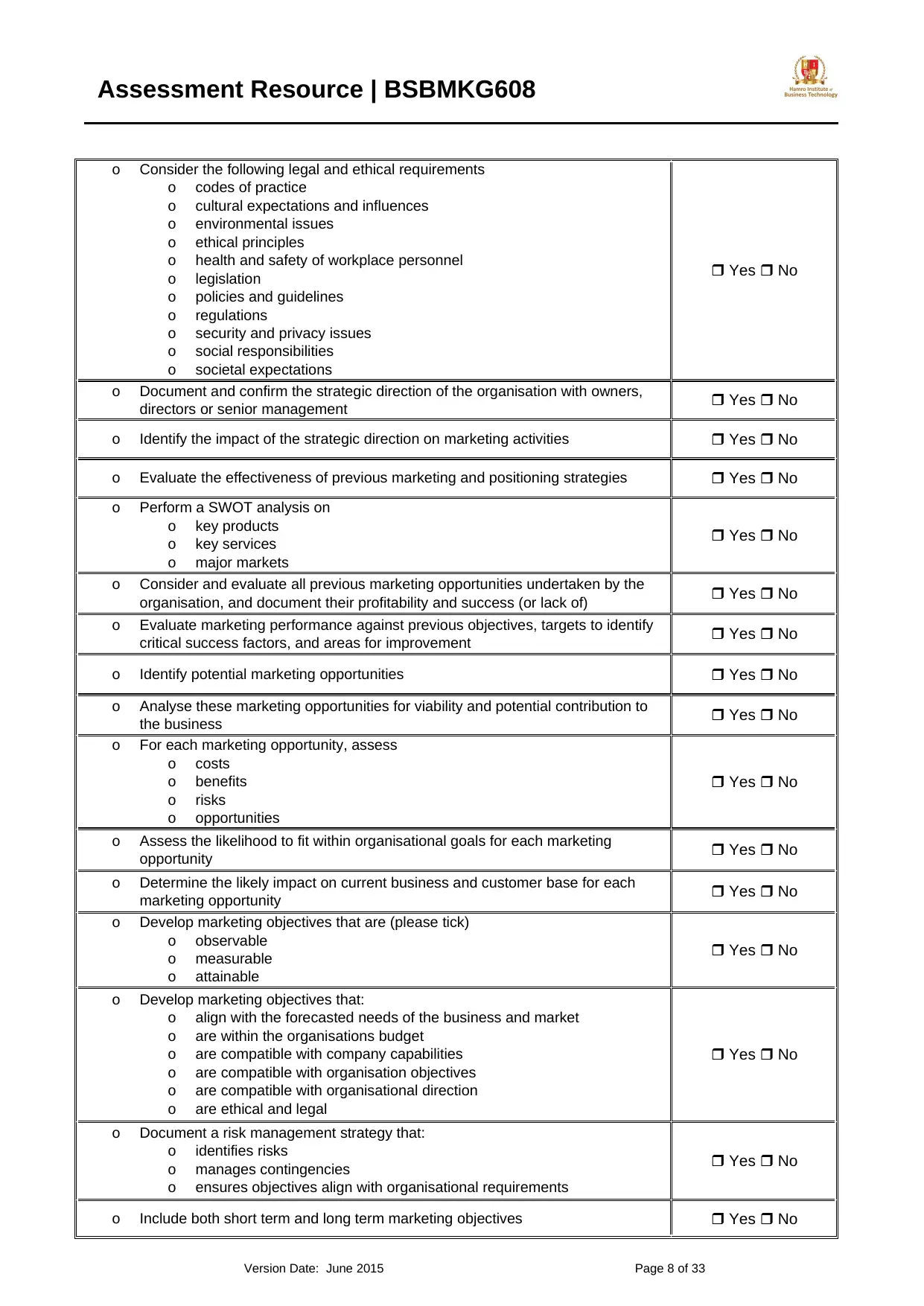
Assessment Resource | BSBMKG608
o Consider the following legal and ethical requirements
o codes of practice
o cultural expectations and influences
o environmental issues
o ethical principles
o health and safety of workplace personnel
o legislation
o policies and guidelines
o regulations
o security and privacy issues
o social responsibilities
o societal expectations
Yes No
o Document and confirm the strategic direction of the organisation with owners,
directors or senior management Yes No
o Identify the impact of the strategic direction on marketing activities Yes No
o Evaluate the effectiveness of previous marketing and positioning strategies Yes No
o Perform a SWOT analysis on
o key products
o key services
o major markets
Yes No
o Consider and evaluate all previous marketing opportunities undertaken by the
organisation, and document their profitability and success (or lack of) Yes No
o Evaluate marketing performance against previous objectives, targets to identify
critical success factors, and areas for improvement Yes No
o Identify potential marketing opportunities Yes No
o Analyse these marketing opportunities for viability and potential contribution to
the business Yes No
o For each marketing opportunity, assess
o costs
o benefits
o risks
o opportunities
Yes No
o Assess the likelihood to fit within organisational goals for each marketing
opportunity Yes No
o Determine the likely impact on current business and customer base for each
marketing opportunity Yes No
o Develop marketing objectives that are (please tick)
o observable
o measurable
o attainable
Yes No
o Develop marketing objectives that:
o align with the forecasted needs of the business and market
o are within the organisations budget
o are compatible with company capabilities
o are compatible with organisation objectives
o are compatible with organisational direction
o are ethical and legal
Yes No
o Document a risk management strategy that:
o identifies risks
o manages contingencies
o ensures objectives align with organisational requirements
Yes No
o Include both short term and long term marketing objectives Yes No
Version Date: June 2015 Page 8 of 33
o Consider the following legal and ethical requirements
o codes of practice
o cultural expectations and influences
o environmental issues
o ethical principles
o health and safety of workplace personnel
o legislation
o policies and guidelines
o regulations
o security and privacy issues
o social responsibilities
o societal expectations
Yes No
o Document and confirm the strategic direction of the organisation with owners,
directors or senior management Yes No
o Identify the impact of the strategic direction on marketing activities Yes No
o Evaluate the effectiveness of previous marketing and positioning strategies Yes No
o Perform a SWOT analysis on
o key products
o key services
o major markets
Yes No
o Consider and evaluate all previous marketing opportunities undertaken by the
organisation, and document their profitability and success (or lack of) Yes No
o Evaluate marketing performance against previous objectives, targets to identify
critical success factors, and areas for improvement Yes No
o Identify potential marketing opportunities Yes No
o Analyse these marketing opportunities for viability and potential contribution to
the business Yes No
o For each marketing opportunity, assess
o costs
o benefits
o risks
o opportunities
Yes No
o Assess the likelihood to fit within organisational goals for each marketing
opportunity Yes No
o Determine the likely impact on current business and customer base for each
marketing opportunity Yes No
o Develop marketing objectives that are (please tick)
o observable
o measurable
o attainable
Yes No
o Develop marketing objectives that:
o align with the forecasted needs of the business and market
o are within the organisations budget
o are compatible with company capabilities
o are compatible with organisation objectives
o are compatible with organisational direction
o are ethical and legal
Yes No
o Document a risk management strategy that:
o identifies risks
o manages contingencies
o ensures objectives align with organisational requirements
Yes No
o Include both short term and long term marketing objectives Yes No
Version Date: June 2015 Page 8 of 33
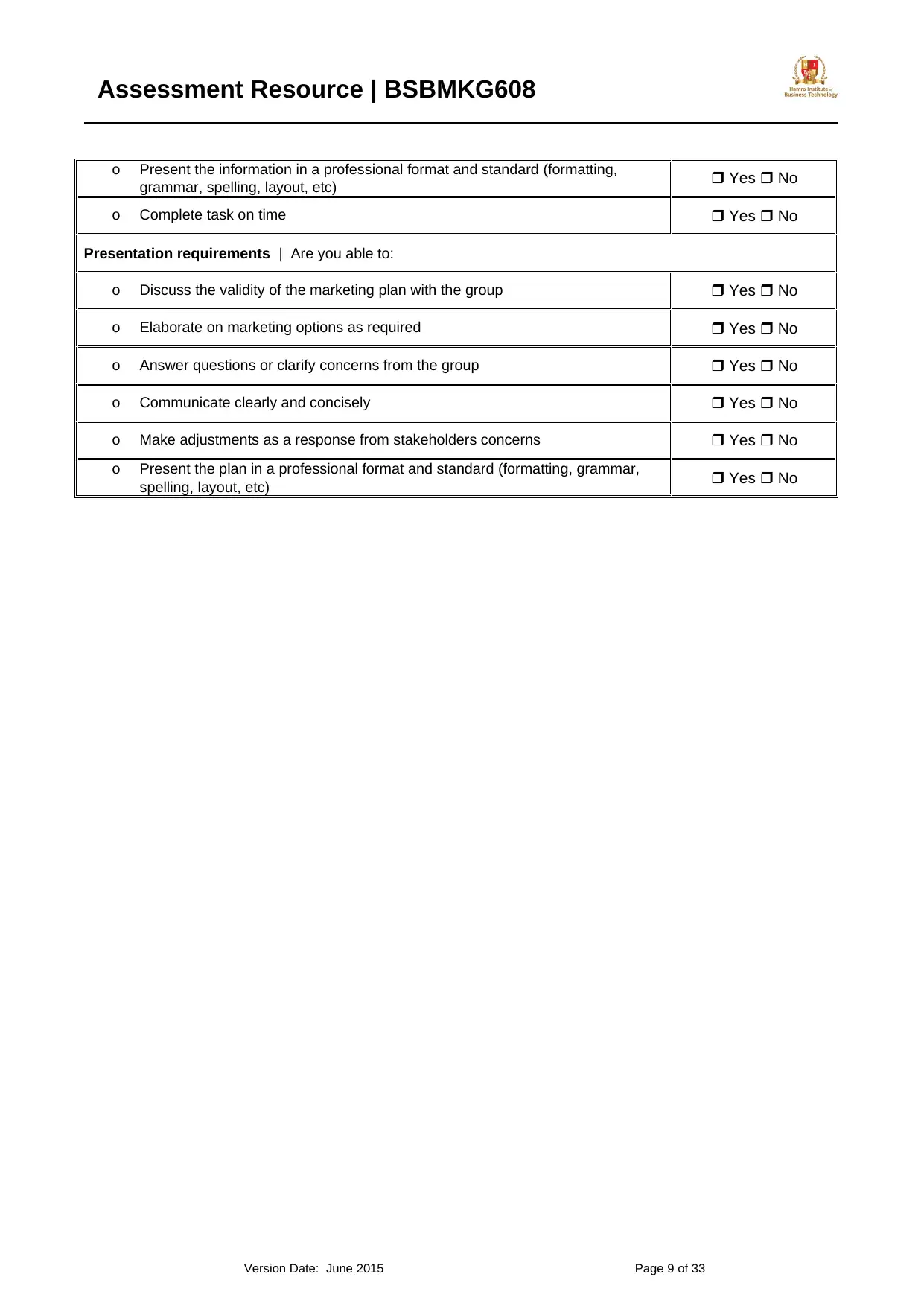
Assessment Resource | BSBMKG608
o Present the information in a professional format and standard (formatting,
grammar, spelling, layout, etc) Yes No
o Complete task on time Yes No
Presentation requirements | Are you able to:
o Discuss the validity of the marketing plan with the group Yes No
o Elaborate on marketing options as required Yes No
o Answer questions or clarify concerns from the group Yes No
o Communicate clearly and concisely Yes No
o Make adjustments as a response from stakeholders concerns Yes No
o Present the plan in a professional format and standard (formatting, grammar,
spelling, layout, etc) Yes No
Version Date: June 2015 Page 9 of 33
o Present the information in a professional format and standard (formatting,
grammar, spelling, layout, etc) Yes No
o Complete task on time Yes No
Presentation requirements | Are you able to:
o Discuss the validity of the marketing plan with the group Yes No
o Elaborate on marketing options as required Yes No
o Answer questions or clarify concerns from the group Yes No
o Communicate clearly and concisely Yes No
o Make adjustments as a response from stakeholders concerns Yes No
o Present the plan in a professional format and standard (formatting, grammar,
spelling, layout, etc) Yes No
Version Date: June 2015 Page 9 of 33
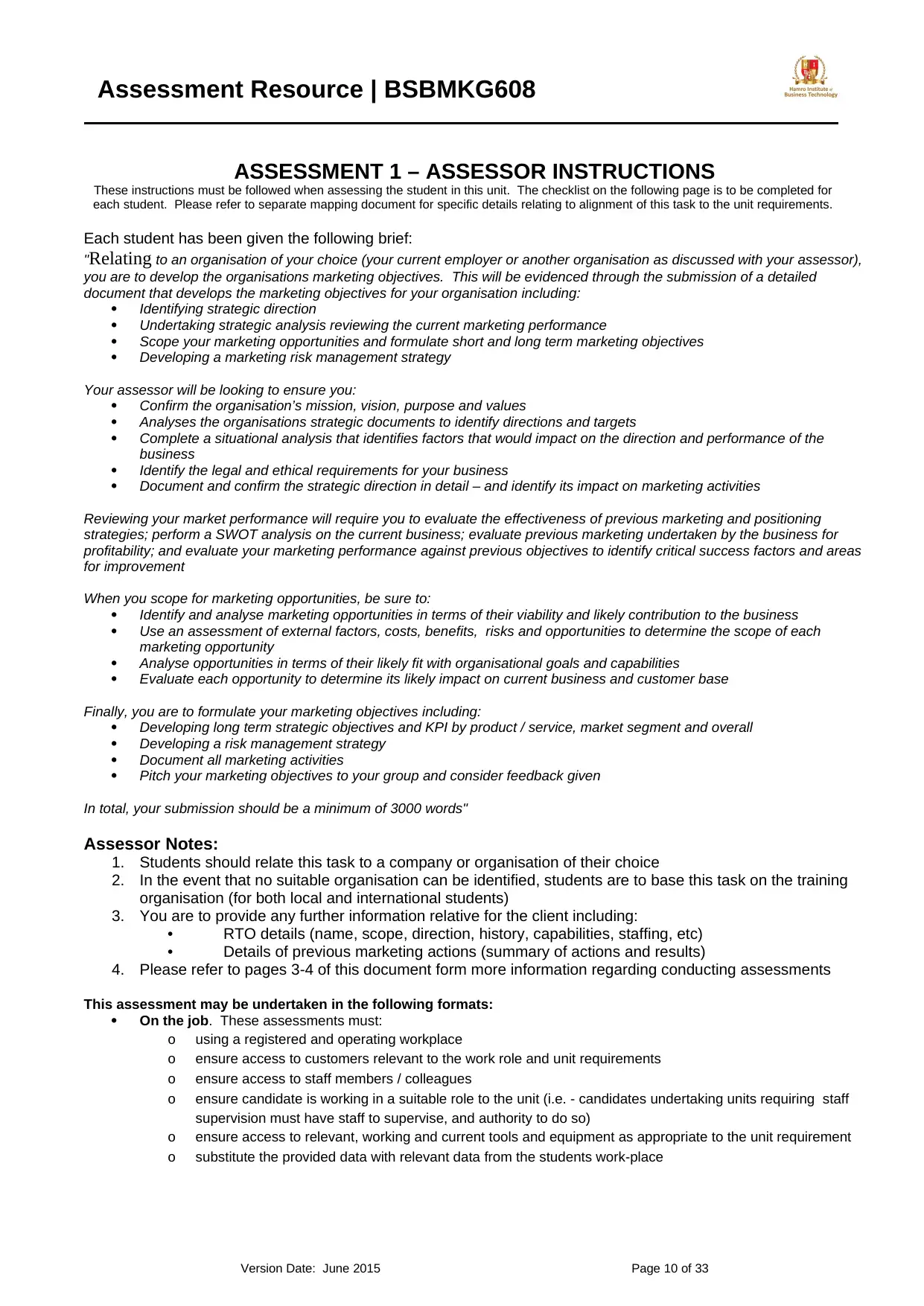
Assessment Resource | BSBMKG608
ASSESSMENT 1 – ASSESSOR INSTRUCTIONS
These instructions must be followed when assessing the student in this unit. The checklist on the following page is to be completed for
each student. Please refer to separate mapping document for specific details relating to alignment of this task to the unit requirements.
Each student has been given the following brief:
"Relating to an organisation of your choice (your current employer or another organisation as discussed with your assessor),
you are to develop the organisations marketing objectives. This will be evidenced through the submission of a detailed
document that develops the marketing objectives for your organisation including:
Identifying strategic direction
Undertaking strategic analysis reviewing the current marketing performance
Scope your marketing opportunities and formulate short and long term marketing objectives
Developing a marketing risk management strategy
Your assessor will be looking to ensure you:
Confirm the organisation’s mission, vision, purpose and values
Analyses the organisations strategic documents to identify directions and targets
Complete a situational analysis that identifies factors that would impact on the direction and performance of the
business
Identify the legal and ethical requirements for your business
Document and confirm the strategic direction in detail – and identify its impact on marketing activities
Reviewing your market performance will require you to evaluate the effectiveness of previous marketing and positioning
strategies; perform a SWOT analysis on the current business; evaluate previous marketing undertaken by the business for
profitability; and evaluate your marketing performance against previous objectives to identify critical success factors and areas
for improvement
When you scope for marketing opportunities, be sure to:
Identify and analyse marketing opportunities in terms of their viability and likely contribution to the business
Use an assessment of external factors, costs, benefits, risks and opportunities to determine the scope of each
marketing opportunity
Analyse opportunities in terms of their likely fit with organisational goals and capabilities
Evaluate each opportunity to determine its likely impact on current business and customer base
Finally, you are to formulate your marketing objectives including:
Developing long term strategic objectives and KPI by product / service, market segment and overall
Developing a risk management strategy
Document all marketing activities
Pitch your marketing objectives to your group and consider feedback given
In total, your submission should be a minimum of 3000 words"
Assessor Notes:
1. Students should relate this task to a company or organisation of their choice
2. In the event that no suitable organisation can be identified, students are to base this task on the training
organisation (for both local and international students)
3. You are to provide any further information relative for the client including:
• RTO details (name, scope, direction, history, capabilities, staffing, etc)
• Details of previous marketing actions (summary of actions and results)
4. Please refer to pages 3-4 of this document form more information regarding conducting assessments
This assessment may be undertaken in the following formats:
On the job. These assessments must:
o using a registered and operating workplace
o ensure access to customers relevant to the work role and unit requirements
o ensure access to staff members / colleagues
o ensure candidate is working in a suitable role to the unit (i.e. - candidates undertaking units requiring staff
supervision must have staff to supervise, and authority to do so)
o ensure access to relevant, working and current tools and equipment as appropriate to the unit requirement
o substitute the provided data with relevant data from the students work-place
Version Date: June 2015 Page 10 of 33
ASSESSMENT 1 – ASSESSOR INSTRUCTIONS
These instructions must be followed when assessing the student in this unit. The checklist on the following page is to be completed for
each student. Please refer to separate mapping document for specific details relating to alignment of this task to the unit requirements.
Each student has been given the following brief:
"Relating to an organisation of your choice (your current employer or another organisation as discussed with your assessor),
you are to develop the organisations marketing objectives. This will be evidenced through the submission of a detailed
document that develops the marketing objectives for your organisation including:
Identifying strategic direction
Undertaking strategic analysis reviewing the current marketing performance
Scope your marketing opportunities and formulate short and long term marketing objectives
Developing a marketing risk management strategy
Your assessor will be looking to ensure you:
Confirm the organisation’s mission, vision, purpose and values
Analyses the organisations strategic documents to identify directions and targets
Complete a situational analysis that identifies factors that would impact on the direction and performance of the
business
Identify the legal and ethical requirements for your business
Document and confirm the strategic direction in detail – and identify its impact on marketing activities
Reviewing your market performance will require you to evaluate the effectiveness of previous marketing and positioning
strategies; perform a SWOT analysis on the current business; evaluate previous marketing undertaken by the business for
profitability; and evaluate your marketing performance against previous objectives to identify critical success factors and areas
for improvement
When you scope for marketing opportunities, be sure to:
Identify and analyse marketing opportunities in terms of their viability and likely contribution to the business
Use an assessment of external factors, costs, benefits, risks and opportunities to determine the scope of each
marketing opportunity
Analyse opportunities in terms of their likely fit with organisational goals and capabilities
Evaluate each opportunity to determine its likely impact on current business and customer base
Finally, you are to formulate your marketing objectives including:
Developing long term strategic objectives and KPI by product / service, market segment and overall
Developing a risk management strategy
Document all marketing activities
Pitch your marketing objectives to your group and consider feedback given
In total, your submission should be a minimum of 3000 words"
Assessor Notes:
1. Students should relate this task to a company or organisation of their choice
2. In the event that no suitable organisation can be identified, students are to base this task on the training
organisation (for both local and international students)
3. You are to provide any further information relative for the client including:
• RTO details (name, scope, direction, history, capabilities, staffing, etc)
• Details of previous marketing actions (summary of actions and results)
4. Please refer to pages 3-4 of this document form more information regarding conducting assessments
This assessment may be undertaken in the following formats:
On the job. These assessments must:
o using a registered and operating workplace
o ensure access to customers relevant to the work role and unit requirements
o ensure access to staff members / colleagues
o ensure candidate is working in a suitable role to the unit (i.e. - candidates undertaking units requiring staff
supervision must have staff to supervise, and authority to do so)
o ensure access to relevant, working and current tools and equipment as appropriate to the unit requirement
o substitute the provided data with relevant data from the students work-place
Version Date: June 2015 Page 10 of 33
Secure Best Marks with AI Grader
Need help grading? Try our AI Grader for instant feedback on your assignments.
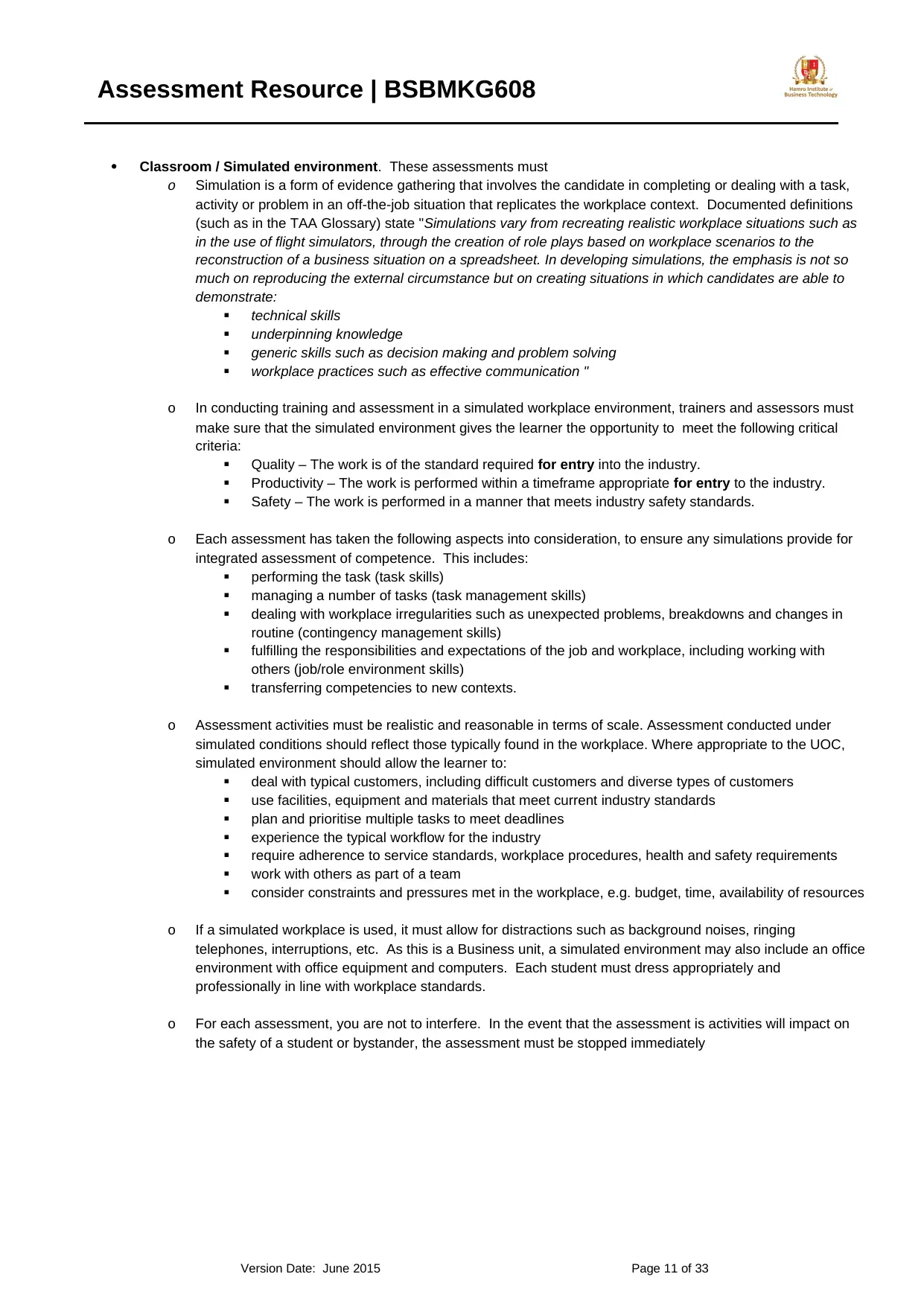
Assessment Resource | BSBMKG608
Classroom / Simulated environment. These assessments must
o Simulation is a form of evidence gathering that involves the candidate in completing or dealing with a task,
activity or problem in an off-the-job situation that replicates the workplace context. Documented definitions
(such as in the TAA Glossary) state "Simulations vary from recreating realistic workplace situations such as
in the use of flight simulators, through the creation of role plays based on workplace scenarios to the
reconstruction of a business situation on a spreadsheet. In developing simulations, the emphasis is not so
much on reproducing the external circumstance but on creating situations in which candidates are able to
demonstrate:
technical skills
underpinning knowledge
generic skills such as decision making and problem solving
workplace practices such as effective communication "
o In conducting training and assessment in a simulated workplace environment, trainers and assessors must
make sure that the simulated environment gives the learner the opportunity to meet the following critical
criteria:
Quality – The work is of the standard required for entry into the industry.
Productivity – The work is performed within a timeframe appropriate for entry to the industry.
Safety – The work is performed in a manner that meets industry safety standards.
o Each assessment has taken the following aspects into consideration, to ensure any simulations provide for
integrated assessment of competence. This includes:
performing the task (task skills)
managing a number of tasks (task management skills)
dealing with workplace irregularities such as unexpected problems, breakdowns and changes in
routine (contingency management skills)
fulfilling the responsibilities and expectations of the job and workplace, including working with
others (job/role environment skills)
transferring competencies to new contexts.
o Assessment activities must be realistic and reasonable in terms of scale. Assessment conducted under
simulated conditions should reflect those typically found in the workplace. Where appropriate to the UOC,
simulated environment should allow the learner to:
deal with typical customers, including difficult customers and diverse types of customers
use facilities, equipment and materials that meet current industry standards
plan and prioritise multiple tasks to meet deadlines
experience the typical workflow for the industry
require adherence to service standards, workplace procedures, health and safety requirements
work with others as part of a team
consider constraints and pressures met in the workplace, e.g. budget, time, availability of resources
o If a simulated workplace is used, it must allow for distractions such as background noises, ringing
telephones, interruptions, etc. As this is a Business unit, a simulated environment may also include an office
environment with office equipment and computers. Each student must dress appropriately and
professionally in line with workplace standards.
o For each assessment, you are not to interfere. In the event that the assessment is activities will impact on
the safety of a student or bystander, the assessment must be stopped immediately
Version Date: June 2015 Page 11 of 33
Classroom / Simulated environment. These assessments must
o Simulation is a form of evidence gathering that involves the candidate in completing or dealing with a task,
activity or problem in an off-the-job situation that replicates the workplace context. Documented definitions
(such as in the TAA Glossary) state "Simulations vary from recreating realistic workplace situations such as
in the use of flight simulators, through the creation of role plays based on workplace scenarios to the
reconstruction of a business situation on a spreadsheet. In developing simulations, the emphasis is not so
much on reproducing the external circumstance but on creating situations in which candidates are able to
demonstrate:
technical skills
underpinning knowledge
generic skills such as decision making and problem solving
workplace practices such as effective communication "
o In conducting training and assessment in a simulated workplace environment, trainers and assessors must
make sure that the simulated environment gives the learner the opportunity to meet the following critical
criteria:
Quality – The work is of the standard required for entry into the industry.
Productivity – The work is performed within a timeframe appropriate for entry to the industry.
Safety – The work is performed in a manner that meets industry safety standards.
o Each assessment has taken the following aspects into consideration, to ensure any simulations provide for
integrated assessment of competence. This includes:
performing the task (task skills)
managing a number of tasks (task management skills)
dealing with workplace irregularities such as unexpected problems, breakdowns and changes in
routine (contingency management skills)
fulfilling the responsibilities and expectations of the job and workplace, including working with
others (job/role environment skills)
transferring competencies to new contexts.
o Assessment activities must be realistic and reasonable in terms of scale. Assessment conducted under
simulated conditions should reflect those typically found in the workplace. Where appropriate to the UOC,
simulated environment should allow the learner to:
deal with typical customers, including difficult customers and diverse types of customers
use facilities, equipment and materials that meet current industry standards
plan and prioritise multiple tasks to meet deadlines
experience the typical workflow for the industry
require adherence to service standards, workplace procedures, health and safety requirements
work with others as part of a team
consider constraints and pressures met in the workplace, e.g. budget, time, availability of resources
o If a simulated workplace is used, it must allow for distractions such as background noises, ringing
telephones, interruptions, etc. As this is a Business unit, a simulated environment may also include an office
environment with office equipment and computers. Each student must dress appropriately and
professionally in line with workplace standards.
o For each assessment, you are not to interfere. In the event that the assessment is activities will impact on
the safety of a student or bystander, the assessment must be stopped immediately
Version Date: June 2015 Page 11 of 33

Assessment Resource | BSBMKG608
ASSESSMENT 1 – ASSESSOR CHECKLIST
This checklist is to be used when assessing the students in this task. This checklist is to be completed for each student. Please refer to
separate mapping document for specific details relating to alignment of this task to the unit requirements.
Please complete below
Student Name: Sandip Panthi
Student ID No: 1400632
Did the student: Satisfactory Comments
Identify / confirm the organisation’s mission (1 - 2 sentences) Yes No
Identify / confirm the organisation’s vision (1- 3 paragraph) Yes No
Research the organisations purpose and value from either
internal materials, owners, directors or senior management Yes No
Identify the organisational directions Yes No
Identify the organisations targets Yes No
Undertake a situational analysis that includes (please tick)
collaborators analysis
competitive analysis
environmental analysis
market analysis
market measurements
productivity or profitability analysis
Yes No
Consider the following legal and ethical requirements (please
tick)
codes of practice
cultural expectations and influences
environmental issues
ethical principles
health and safety of workplace personnel
legislation
policies and guidelines
regulations
security and privacy issues
social responsibilities
societal expectations
Yes No
Document and confirm the strategic direction of the
organisation with owners, directors or senior management Yes No
Identify the impact of the strategic direction on marketing
activities Yes No
Version Date: June 2015 Page 12 of 33
ASSESSMENT 1 – ASSESSOR CHECKLIST
This checklist is to be used when assessing the students in this task. This checklist is to be completed for each student. Please refer to
separate mapping document for specific details relating to alignment of this task to the unit requirements.
Please complete below
Student Name: Sandip Panthi
Student ID No: 1400632
Did the student: Satisfactory Comments
Identify / confirm the organisation’s mission (1 - 2 sentences) Yes No
Identify / confirm the organisation’s vision (1- 3 paragraph) Yes No
Research the organisations purpose and value from either
internal materials, owners, directors or senior management Yes No
Identify the organisational directions Yes No
Identify the organisations targets Yes No
Undertake a situational analysis that includes (please tick)
collaborators analysis
competitive analysis
environmental analysis
market analysis
market measurements
productivity or profitability analysis
Yes No
Consider the following legal and ethical requirements (please
tick)
codes of practice
cultural expectations and influences
environmental issues
ethical principles
health and safety of workplace personnel
legislation
policies and guidelines
regulations
security and privacy issues
social responsibilities
societal expectations
Yes No
Document and confirm the strategic direction of the
organisation with owners, directors or senior management Yes No
Identify the impact of the strategic direction on marketing
activities Yes No
Version Date: June 2015 Page 12 of 33
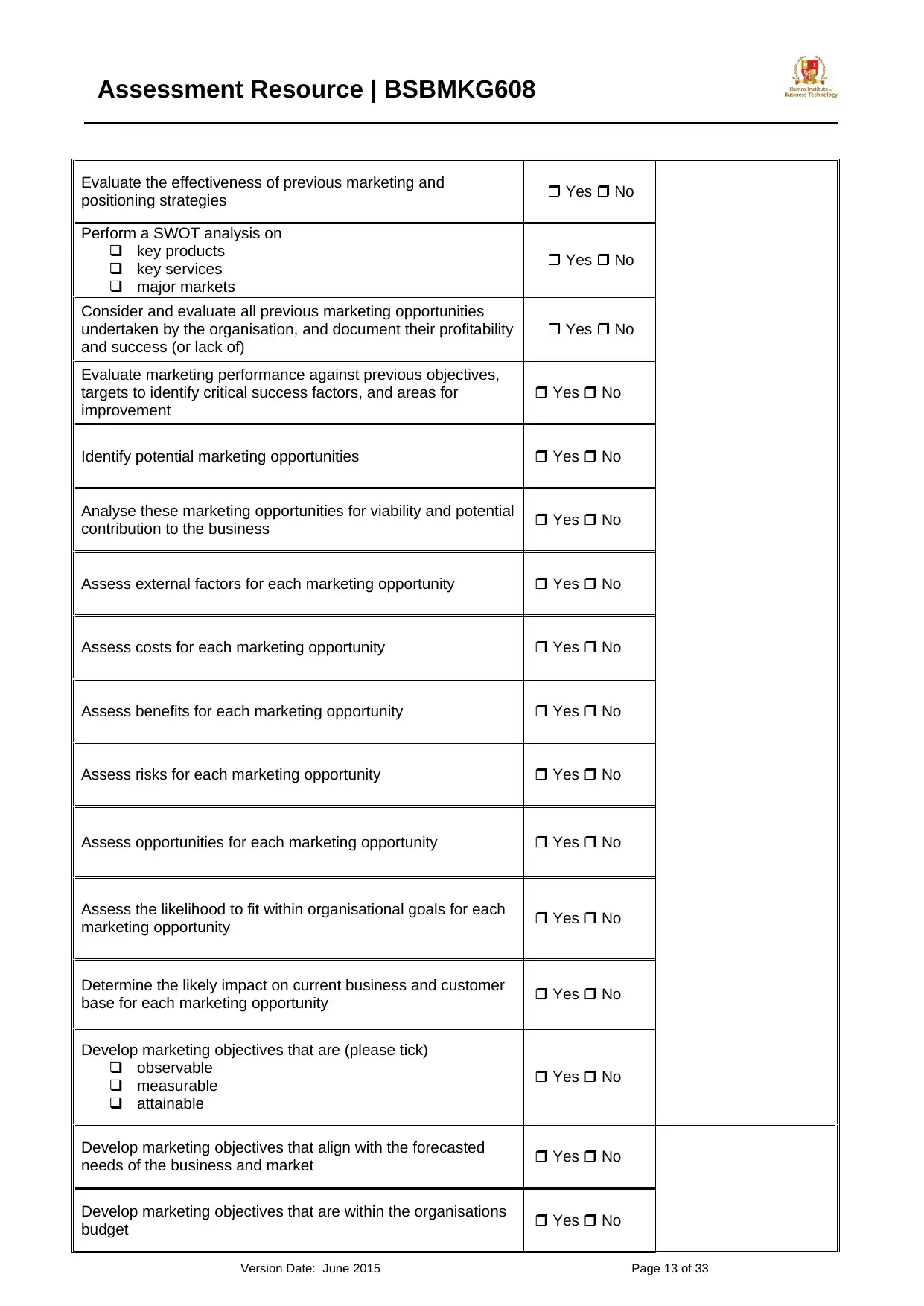
Assessment Resource | BSBMKG608
Evaluate the effectiveness of previous marketing and
positioning strategies Yes No
Perform a SWOT analysis on
key products
key services
major markets
Yes No
Consider and evaluate all previous marketing opportunities
undertaken by the organisation, and document their profitability
and success (or lack of)
Yes No
Evaluate marketing performance against previous objectives,
targets to identify critical success factors, and areas for
improvement
Yes No
Identify potential marketing opportunities Yes No
Analyse these marketing opportunities for viability and potential
contribution to the business Yes No
Assess external factors for each marketing opportunity Yes No
Assess costs for each marketing opportunity Yes No
Assess benefits for each marketing opportunity Yes No
Assess risks for each marketing opportunity Yes No
Assess opportunities for each marketing opportunity Yes No
Assess the likelihood to fit within organisational goals for each
marketing opportunity Yes No
Determine the likely impact on current business and customer
base for each marketing opportunity Yes No
Develop marketing objectives that are (please tick)
observable
measurable
attainable
Yes No
Develop marketing objectives that align with the forecasted
needs of the business and market Yes No
Develop marketing objectives that are within the organisations
budget Yes No
Version Date: June 2015 Page 13 of 33
Evaluate the effectiveness of previous marketing and
positioning strategies Yes No
Perform a SWOT analysis on
key products
key services
major markets
Yes No
Consider and evaluate all previous marketing opportunities
undertaken by the organisation, and document their profitability
and success (or lack of)
Yes No
Evaluate marketing performance against previous objectives,
targets to identify critical success factors, and areas for
improvement
Yes No
Identify potential marketing opportunities Yes No
Analyse these marketing opportunities for viability and potential
contribution to the business Yes No
Assess external factors for each marketing opportunity Yes No
Assess costs for each marketing opportunity Yes No
Assess benefits for each marketing opportunity Yes No
Assess risks for each marketing opportunity Yes No
Assess opportunities for each marketing opportunity Yes No
Assess the likelihood to fit within organisational goals for each
marketing opportunity Yes No
Determine the likely impact on current business and customer
base for each marketing opportunity Yes No
Develop marketing objectives that are (please tick)
observable
measurable
attainable
Yes No
Develop marketing objectives that align with the forecasted
needs of the business and market Yes No
Develop marketing objectives that are within the organisations
budget Yes No
Version Date: June 2015 Page 13 of 33
Paraphrase This Document
Need a fresh take? Get an instant paraphrase of this document with our AI Paraphraser
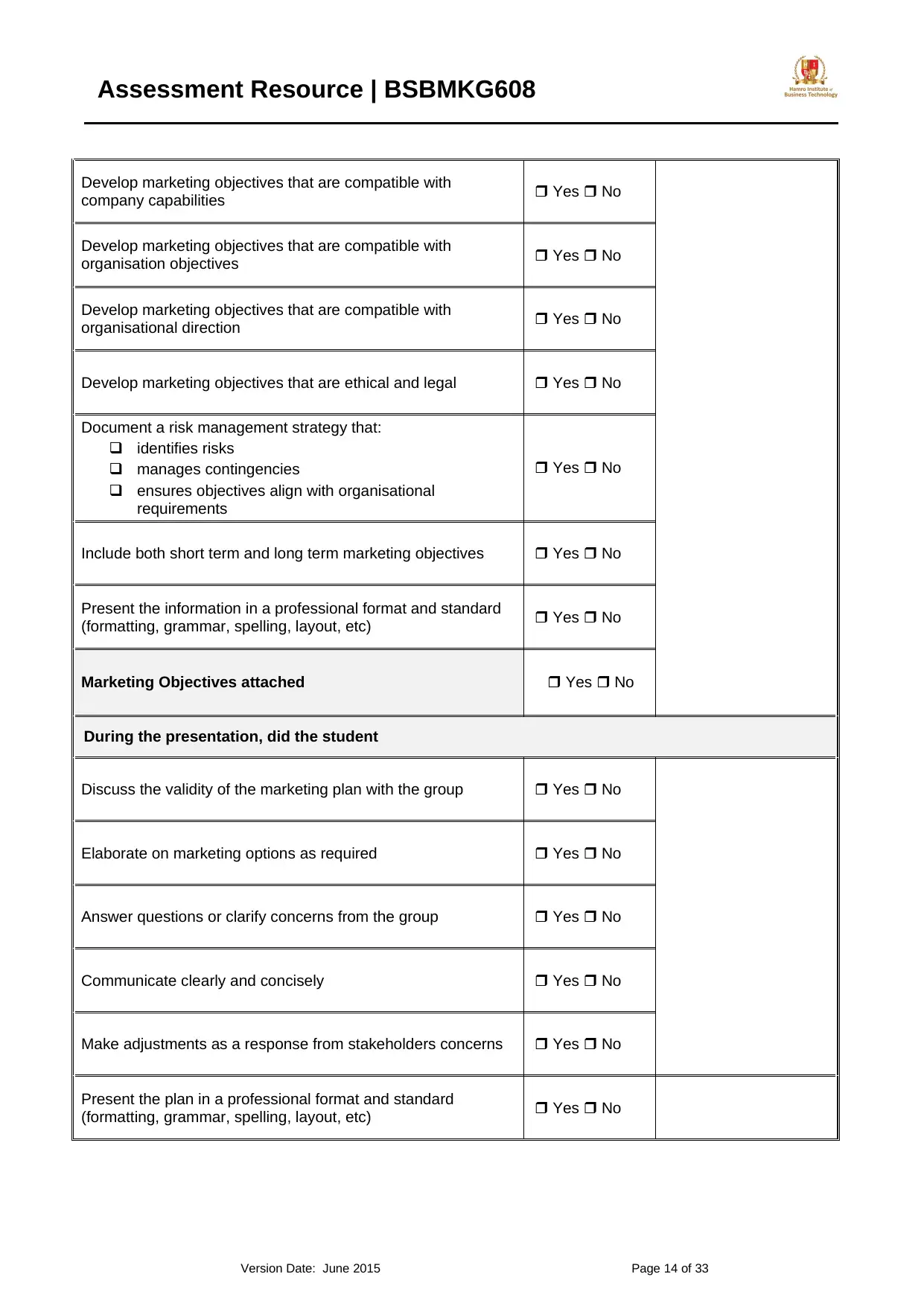
Assessment Resource | BSBMKG608
Develop marketing objectives that are compatible with
company capabilities Yes No
Develop marketing objectives that are compatible with
organisation objectives Yes No
Develop marketing objectives that are compatible with
organisational direction Yes No
Develop marketing objectives that are ethical and legal Yes No
Document a risk management strategy that:
identifies risks
manages contingencies
ensures objectives align with organisational
requirements
Yes No
Include both short term and long term marketing objectives Yes No
Present the information in a professional format and standard
(formatting, grammar, spelling, layout, etc) Yes No
Marketing Objectives attached Yes No
During the presentation, did the student
Discuss the validity of the marketing plan with the group Yes No
Elaborate on marketing options as required Yes No
Answer questions or clarify concerns from the group Yes No
Communicate clearly and concisely Yes No
Make adjustments as a response from stakeholders concerns Yes No
Present the plan in a professional format and standard
(formatting, grammar, spelling, layout, etc) Yes No
Version Date: June 2015 Page 14 of 33
Develop marketing objectives that are compatible with
company capabilities Yes No
Develop marketing objectives that are compatible with
organisation objectives Yes No
Develop marketing objectives that are compatible with
organisational direction Yes No
Develop marketing objectives that are ethical and legal Yes No
Document a risk management strategy that:
identifies risks
manages contingencies
ensures objectives align with organisational
requirements
Yes No
Include both short term and long term marketing objectives Yes No
Present the information in a professional format and standard
(formatting, grammar, spelling, layout, etc) Yes No
Marketing Objectives attached Yes No
During the presentation, did the student
Discuss the validity of the marketing plan with the group Yes No
Elaborate on marketing options as required Yes No
Answer questions or clarify concerns from the group Yes No
Communicate clearly and concisely Yes No
Make adjustments as a response from stakeholders concerns Yes No
Present the plan in a professional format and standard
(formatting, grammar, spelling, layout, etc) Yes No
Version Date: June 2015 Page 14 of 33
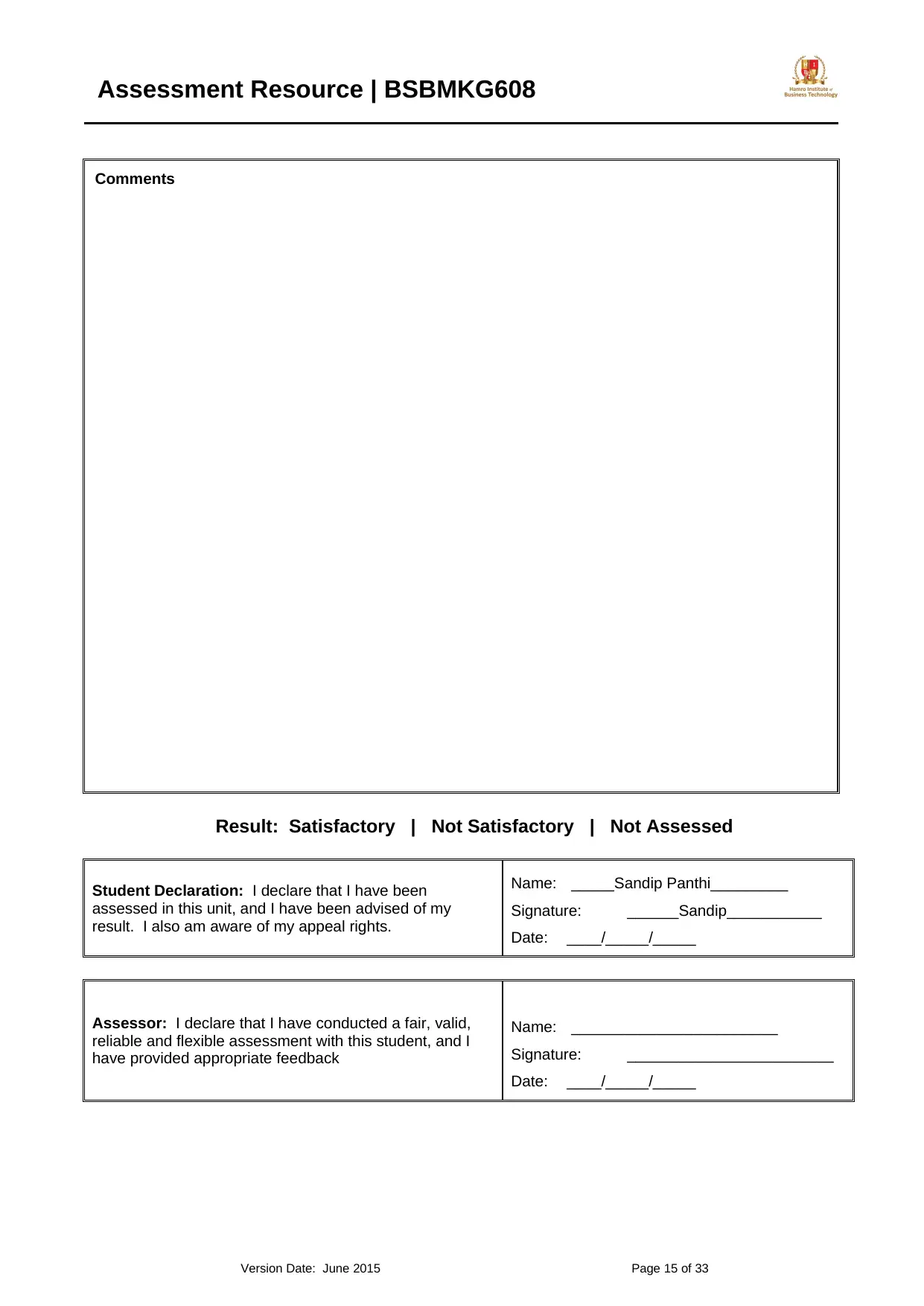
Assessment Resource | BSBMKG608
Comments
Result: Satisfactory | Not Satisfactory | Not Assessed
Student Declaration: I declare that I have been
assessed in this unit, and I have been advised of my
result. I also am aware of my appeal rights.
Name: _____Sandip Panthi_________
Signature: ______Sandip___________
Date: ____/_____/_____
Assessor: I declare that I have conducted a fair, valid,
reliable and flexible assessment with this student, and I
have provided appropriate feedback
Name: ________________________
Signature: ________________________
Date: ____/_____/_____
Version Date: June 2015 Page 15 of 33
Comments
Result: Satisfactory | Not Satisfactory | Not Assessed
Student Declaration: I declare that I have been
assessed in this unit, and I have been advised of my
result. I also am aware of my appeal rights.
Name: _____Sandip Panthi_________
Signature: ______Sandip___________
Date: ____/_____/_____
Assessor: I declare that I have conducted a fair, valid,
reliable and flexible assessment with this student, and I
have provided appropriate feedback
Name: ________________________
Signature: ________________________
Date: ____/_____/_____
Version Date: June 2015 Page 15 of 33
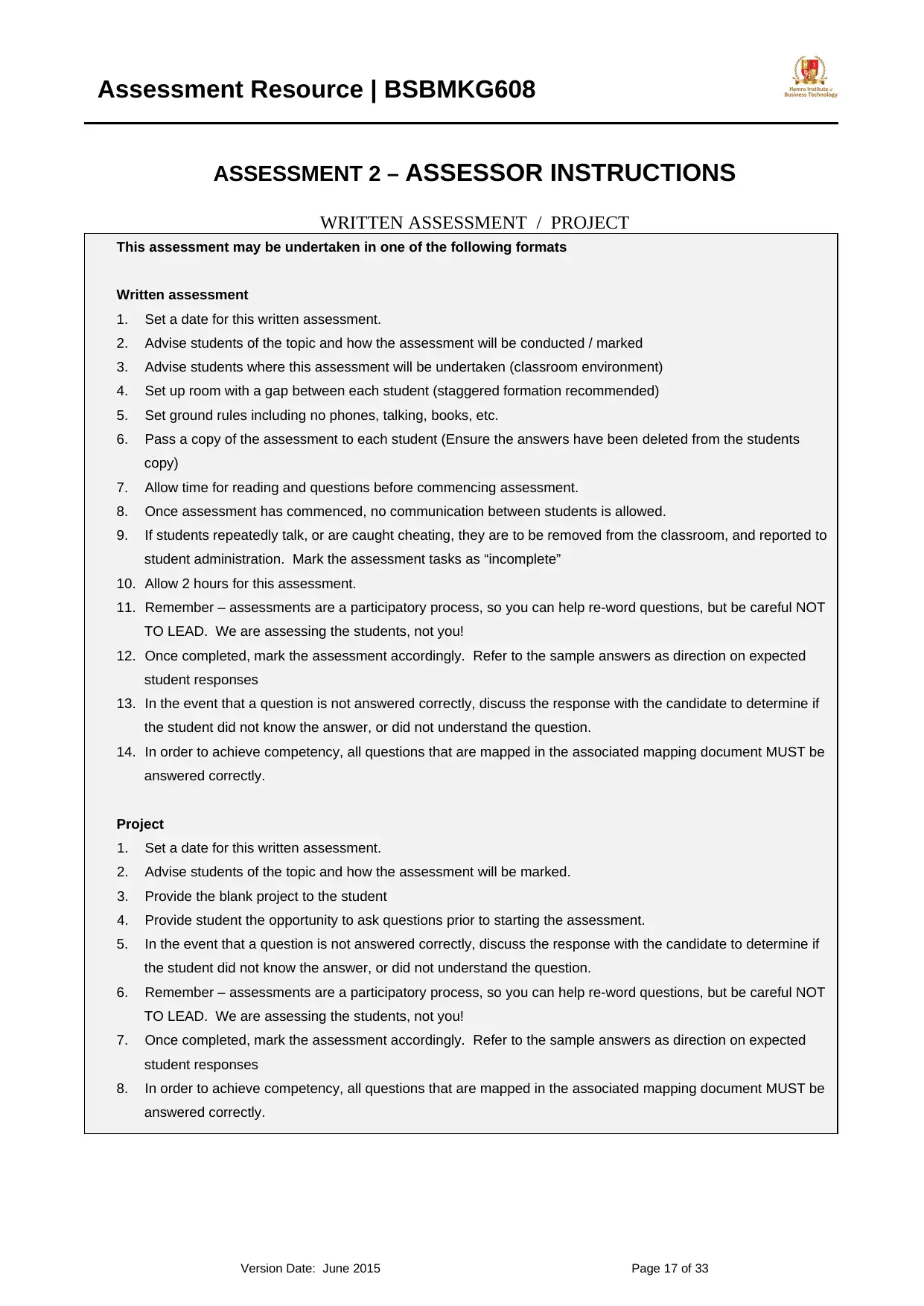
Assessment Resource | BSBMKG608
ASSESSMENT 2 – ASSESSOR INSTRUCTIONS
WRITTEN ASSESSMENT / PROJECT
This assessment may be undertaken in one of the following formats
Written assessment
1. Set a date for this written assessment.
2. Advise students of the topic and how the assessment will be conducted / marked
3. Advise students where this assessment will be undertaken (classroom environment)
4. Set up room with a gap between each student (staggered formation recommended)
5. Set ground rules including no phones, talking, books, etc.
6. Pass a copy of the assessment to each student (Ensure the answers have been deleted from the students
copy)
7. Allow time for reading and questions before commencing assessment.
8. Once assessment has commenced, no communication between students is allowed.
9. If students repeatedly talk, or are caught cheating, they are to be removed from the classroom, and reported to
student administration. Mark the assessment tasks as “incomplete”
10. Allow 2 hours for this assessment.
11. Remember – assessments are a participatory process, so you can help re-word questions, but be careful NOT
TO LEAD. We are assessing the students, not you!
12. Once completed, mark the assessment accordingly. Refer to the sample answers as direction on expected
student responses
13. In the event that a question is not answered correctly, discuss the response with the candidate to determine if
the student did not know the answer, or did not understand the question.
14. In order to achieve competency, all questions that are mapped in the associated mapping document MUST be
answered correctly.
Project
1. Set a date for this written assessment.
2. Advise students of the topic and how the assessment will be marked.
3. Provide the blank project to the student
4. Provide student the opportunity to ask questions prior to starting the assessment.
5. In the event that a question is not answered correctly, discuss the response with the candidate to determine if
the student did not know the answer, or did not understand the question.
6. Remember – assessments are a participatory process, so you can help re-word questions, but be careful NOT
TO LEAD. We are assessing the students, not you!
7. Once completed, mark the assessment accordingly. Refer to the sample answers as direction on expected
student responses
8. In order to achieve competency, all questions that are mapped in the associated mapping document MUST be
answered correctly.
Version Date: June 2015 Page 17 of 33
ASSESSMENT 2 – ASSESSOR INSTRUCTIONS
WRITTEN ASSESSMENT / PROJECT
This assessment may be undertaken in one of the following formats
Written assessment
1. Set a date for this written assessment.
2. Advise students of the topic and how the assessment will be conducted / marked
3. Advise students where this assessment will be undertaken (classroom environment)
4. Set up room with a gap between each student (staggered formation recommended)
5. Set ground rules including no phones, talking, books, etc.
6. Pass a copy of the assessment to each student (Ensure the answers have been deleted from the students
copy)
7. Allow time for reading and questions before commencing assessment.
8. Once assessment has commenced, no communication between students is allowed.
9. If students repeatedly talk, or are caught cheating, they are to be removed from the classroom, and reported to
student administration. Mark the assessment tasks as “incomplete”
10. Allow 2 hours for this assessment.
11. Remember – assessments are a participatory process, so you can help re-word questions, but be careful NOT
TO LEAD. We are assessing the students, not you!
12. Once completed, mark the assessment accordingly. Refer to the sample answers as direction on expected
student responses
13. In the event that a question is not answered correctly, discuss the response with the candidate to determine if
the student did not know the answer, or did not understand the question.
14. In order to achieve competency, all questions that are mapped in the associated mapping document MUST be
answered correctly.
Project
1. Set a date for this written assessment.
2. Advise students of the topic and how the assessment will be marked.
3. Provide the blank project to the student
4. Provide student the opportunity to ask questions prior to starting the assessment.
5. In the event that a question is not answered correctly, discuss the response with the candidate to determine if
the student did not know the answer, or did not understand the question.
6. Remember – assessments are a participatory process, so you can help re-word questions, but be careful NOT
TO LEAD. We are assessing the students, not you!
7. Once completed, mark the assessment accordingly. Refer to the sample answers as direction on expected
student responses
8. In order to achieve competency, all questions that are mapped in the associated mapping document MUST be
answered correctly.
Version Date: June 2015 Page 17 of 33
Secure Best Marks with AI Grader
Need help grading? Try our AI Grader for instant feedback on your assignments.
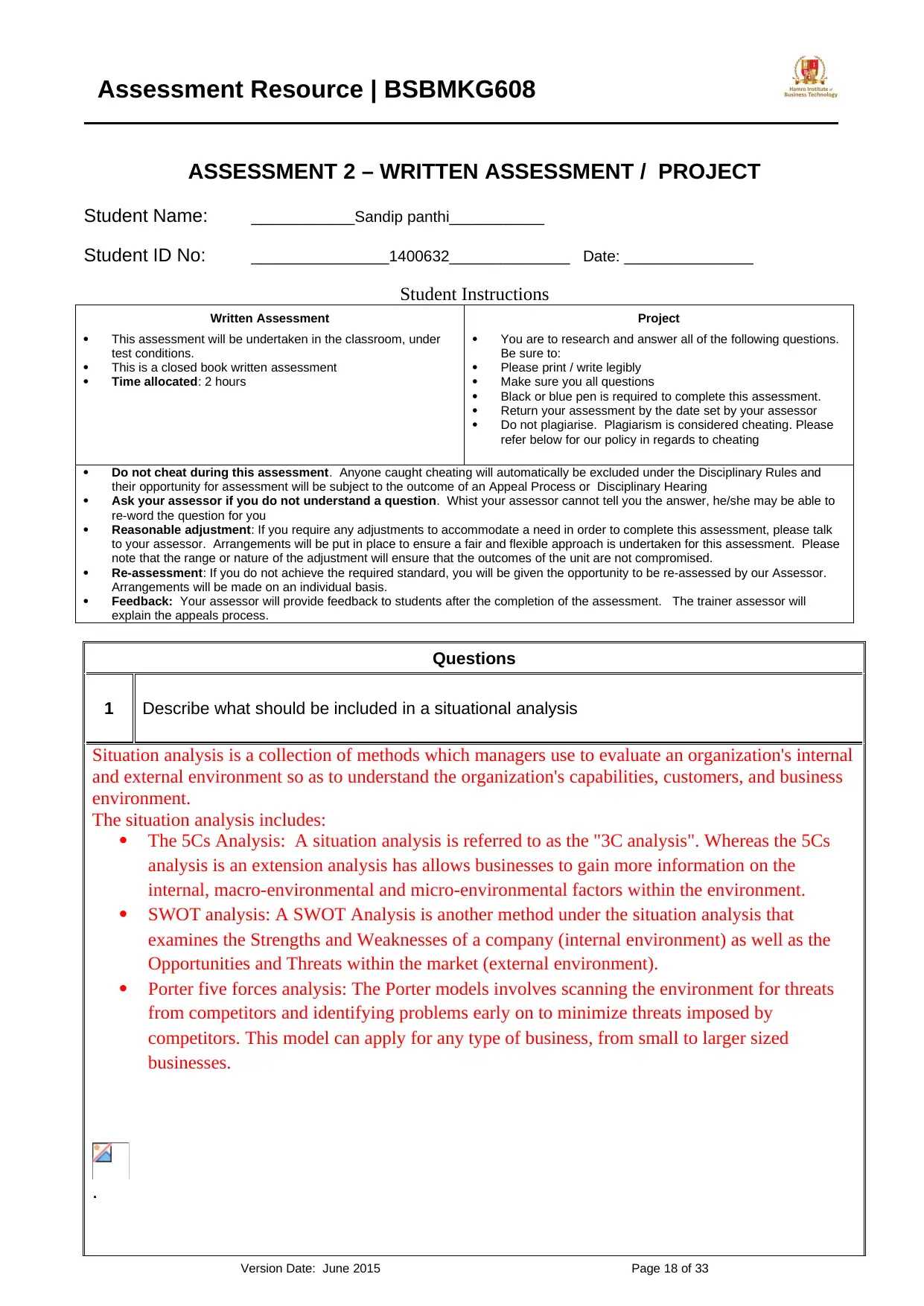
Assessment Resource | BSBMKG608
ASSESSMENT 2 – WRITTEN ASSESSMENT / PROJECT
Student Name: ____________Sandip panthi___________
Student ID No: ________________1400632______________ Date: _______________
Student Instructions
Written Assessment Project
This assessment will be undertaken in the classroom, under
test conditions.
This is a closed book written assessment
Time allocated: 2 hours
You are to research and answer all of the following questions.
Be sure to:
Please print / write legibly
Make sure you all questions
Black or blue pen is required to complete this assessment.
Return your assessment by the date set by your assessor
Do not plagiarise. Plagiarism is considered cheating. Please
refer below for our policy in regards to cheating
Do not cheat during this assessment. Anyone caught cheating will automatically be excluded under the Disciplinary Rules and
their opportunity for assessment will be subject to the outcome of an Appeal Process or Disciplinary Hearing
Ask your assessor if you do not understand a question. Whist your assessor cannot tell you the answer, he/she may be able to
re-word the question for you
Reasonable adjustment: If you require any adjustments to accommodate a need in order to complete this assessment, please talk
to your assessor. Arrangements will be put in place to ensure a fair and flexible approach is undertaken for this assessment. Please
note that the range or nature of the adjustment will ensure that the outcomes of the unit are not compromised.
Re-assessment: If you do not achieve the required standard, you will be given the opportunity to be re-assessed by our Assessor.
Arrangements will be made on an individual basis.
Feedback: Your assessor will provide feedback to students after the completion of the assessment. The trainer assessor will
explain the appeals process.
Questions
1 Describe what should be included in a situational analysis
Situation analysis is a collection of methods which managers use to evaluate an organization's internal
and external environment so as to understand the organization's capabilities, customers, and business
environment.
The situation analysis includes:
The 5Cs Analysis: A situation analysis is referred to as the "3C analysis". Whereas the 5Cs
analysis is an extension analysis has allows businesses to gain more information on the
internal, macro-environmental and micro-environmental factors within the environment.
SWOT analysis: A SWOT Analysis is another method under the situation analysis that
examines the Strengths and Weaknesses of a company (internal environment) as well as the
Opportunities and Threats within the market (external environment).
Porter five forces analysis: The Porter models involves scanning the environment for threats
from competitors and identifying problems early on to minimize threats imposed by
competitors. This model can apply for any type of business, from small to larger sized
businesses.
.
Version Date: June 2015 Page 18 of 33
ASSESSMENT 2 – WRITTEN ASSESSMENT / PROJECT
Student Name: ____________Sandip panthi___________
Student ID No: ________________1400632______________ Date: _______________
Student Instructions
Written Assessment Project
This assessment will be undertaken in the classroom, under
test conditions.
This is a closed book written assessment
Time allocated: 2 hours
You are to research and answer all of the following questions.
Be sure to:
Please print / write legibly
Make sure you all questions
Black or blue pen is required to complete this assessment.
Return your assessment by the date set by your assessor
Do not plagiarise. Plagiarism is considered cheating. Please
refer below for our policy in regards to cheating
Do not cheat during this assessment. Anyone caught cheating will automatically be excluded under the Disciplinary Rules and
their opportunity for assessment will be subject to the outcome of an Appeal Process or Disciplinary Hearing
Ask your assessor if you do not understand a question. Whist your assessor cannot tell you the answer, he/she may be able to
re-word the question for you
Reasonable adjustment: If you require any adjustments to accommodate a need in order to complete this assessment, please talk
to your assessor. Arrangements will be put in place to ensure a fair and flexible approach is undertaken for this assessment. Please
note that the range or nature of the adjustment will ensure that the outcomes of the unit are not compromised.
Re-assessment: If you do not achieve the required standard, you will be given the opportunity to be re-assessed by our Assessor.
Arrangements will be made on an individual basis.
Feedback: Your assessor will provide feedback to students after the completion of the assessment. The trainer assessor will
explain the appeals process.
Questions
1 Describe what should be included in a situational analysis
Situation analysis is a collection of methods which managers use to evaluate an organization's internal
and external environment so as to understand the organization's capabilities, customers, and business
environment.
The situation analysis includes:
The 5Cs Analysis: A situation analysis is referred to as the "3C analysis". Whereas the 5Cs
analysis is an extension analysis has allows businesses to gain more information on the
internal, macro-environmental and micro-environmental factors within the environment.
SWOT analysis: A SWOT Analysis is another method under the situation analysis that
examines the Strengths and Weaknesses of a company (internal environment) as well as the
Opportunities and Threats within the market (external environment).
Porter five forces analysis: The Porter models involves scanning the environment for threats
from competitors and identifying problems early on to minimize threats imposed by
competitors. This model can apply for any type of business, from small to larger sized
businesses.
.
Version Date: June 2015 Page 18 of 33
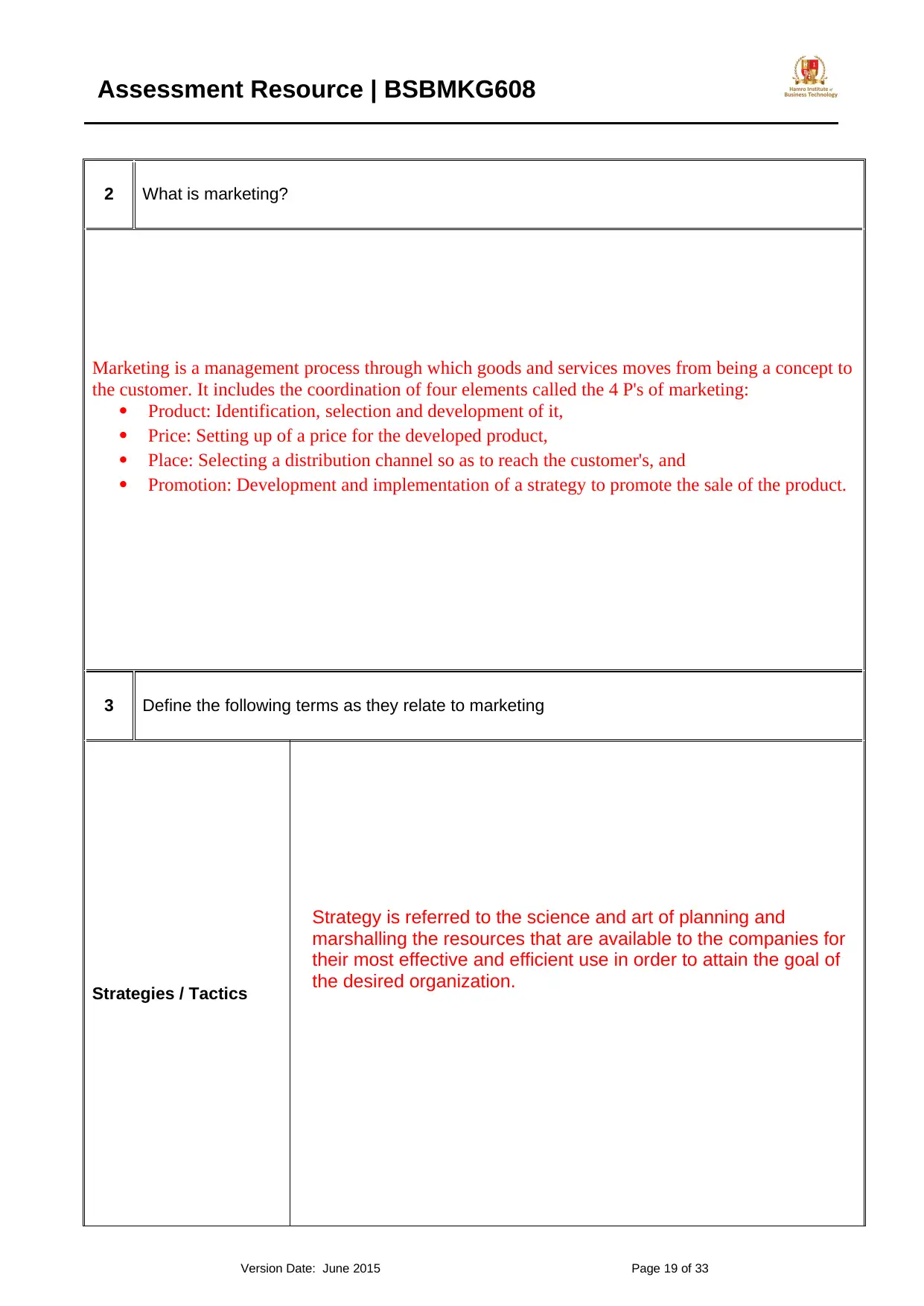
Assessment Resource | BSBMKG608
2 What is marketing?
Marketing is a management process through which goods and services moves from being a concept to
the customer. It includes the coordination of four elements called the 4 P's of marketing:
Product: Identification, selection and development of it,
Price: Setting up of a price for the developed product,
Place: Selecting a distribution channel so as to reach the customer's, and
Promotion: Development and implementation of a strategy to promote the sale of the product.
3 Define the following terms as they relate to marketing
Strategies / Tactics
Strategy is referred to the science and art of planning and
marshalling the resources that are available to the companies for
their most effective and efficient use in order to attain the goal of
the desired organization.
Version Date: June 2015 Page 19 of 33
2 What is marketing?
Marketing is a management process through which goods and services moves from being a concept to
the customer. It includes the coordination of four elements called the 4 P's of marketing:
Product: Identification, selection and development of it,
Price: Setting up of a price for the developed product,
Place: Selecting a distribution channel so as to reach the customer's, and
Promotion: Development and implementation of a strategy to promote the sale of the product.
3 Define the following terms as they relate to marketing
Strategies / Tactics
Strategy is referred to the science and art of planning and
marshalling the resources that are available to the companies for
their most effective and efficient use in order to attain the goal of
the desired organization.
Version Date: June 2015 Page 19 of 33
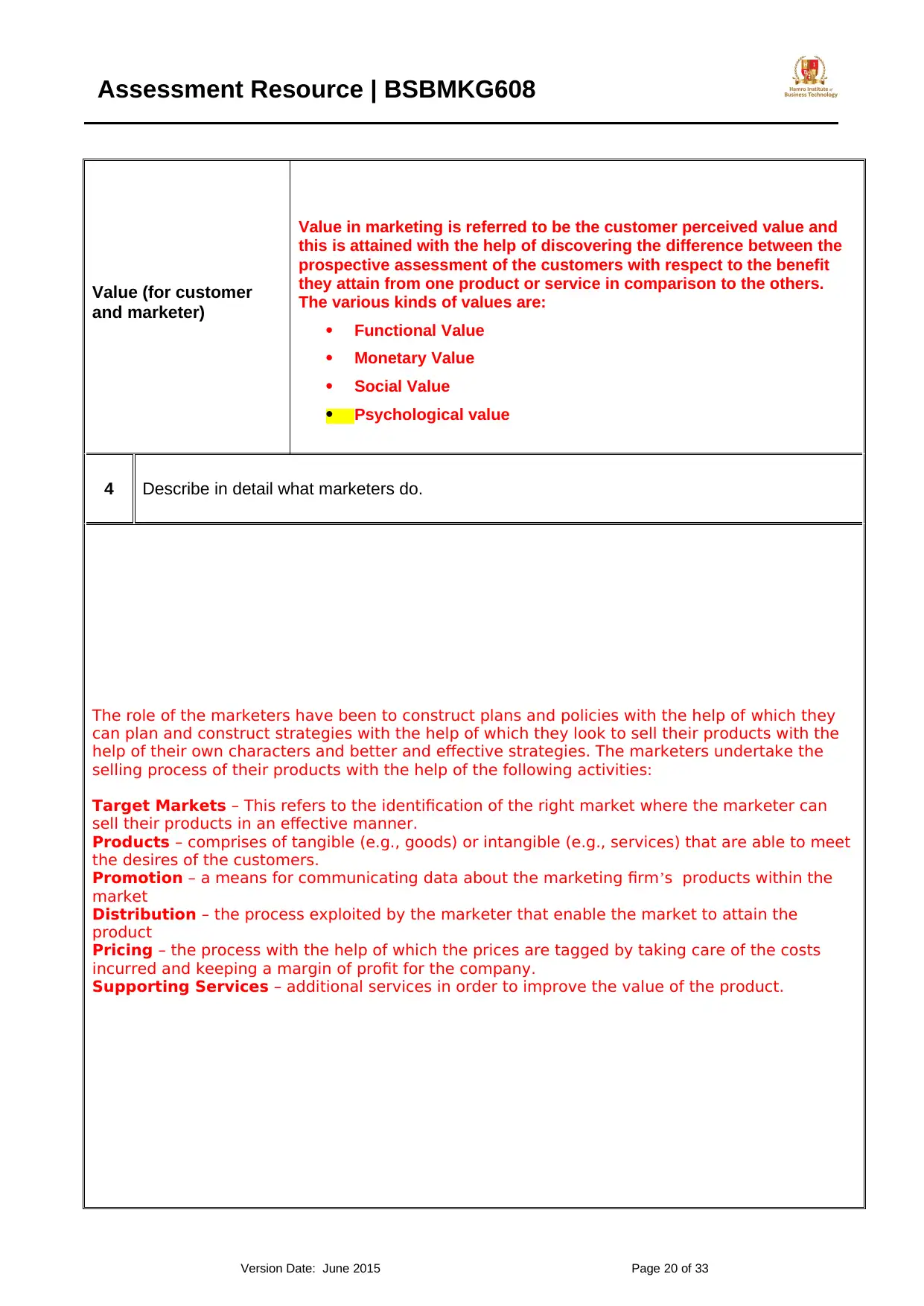
Assessment Resource | BSBMKG608
Value (for customer
and marketer)
Value in marketing is referred to be the customer perceived value and
this is attained with the help of discovering the difference between the
prospective assessment of the customers with respect to the benefit
they attain from one product or service in comparison to the others.
The various kinds of values are:
Functional Value
Monetary Value
Social Value
Psychological value
4 Describe in detail what marketers do.
The role of the marketers have been to construct plans and policies with the help of which they
can plan and construct strategies with the help of which they look to sell their products with the
help of their own characters and better and effective strategies. The marketers undertake the
selling process of their products with the help of the following activities:
Target Markets – This refers to the identification of the right market where the marketer can
sell their products in an effective manner.
Products – comprises of tangible (e.g., goods) or intangible (e.g., services) that are able to meet
the desires of the customers.
Promotion – a means for communicating data about the marketing firm’s products within the
market
Distribution – the process exploited by the marketer that enable the market to attain the
product
Pricing – the process with the help of which the prices are tagged by taking care of the costs
incurred and keeping a margin of profit for the company.
Supporting Services – additional services in order to improve the value of the product.
Version Date: June 2015 Page 20 of 33
Value (for customer
and marketer)
Value in marketing is referred to be the customer perceived value and
this is attained with the help of discovering the difference between the
prospective assessment of the customers with respect to the benefit
they attain from one product or service in comparison to the others.
The various kinds of values are:
Functional Value
Monetary Value
Social Value
Psychological value
4 Describe in detail what marketers do.
The role of the marketers have been to construct plans and policies with the help of which they
can plan and construct strategies with the help of which they look to sell their products with the
help of their own characters and better and effective strategies. The marketers undertake the
selling process of their products with the help of the following activities:
Target Markets – This refers to the identification of the right market where the marketer can
sell their products in an effective manner.
Products – comprises of tangible (e.g., goods) or intangible (e.g., services) that are able to meet
the desires of the customers.
Promotion – a means for communicating data about the marketing firm’s products within the
market
Distribution – the process exploited by the marketer that enable the market to attain the
product
Pricing – the process with the help of which the prices are tagged by taking care of the costs
incurred and keeping a margin of profit for the company.
Supporting Services – additional services in order to improve the value of the product.
Version Date: June 2015 Page 20 of 33
Paraphrase This Document
Need a fresh take? Get an instant paraphrase of this document with our AI Paraphraser
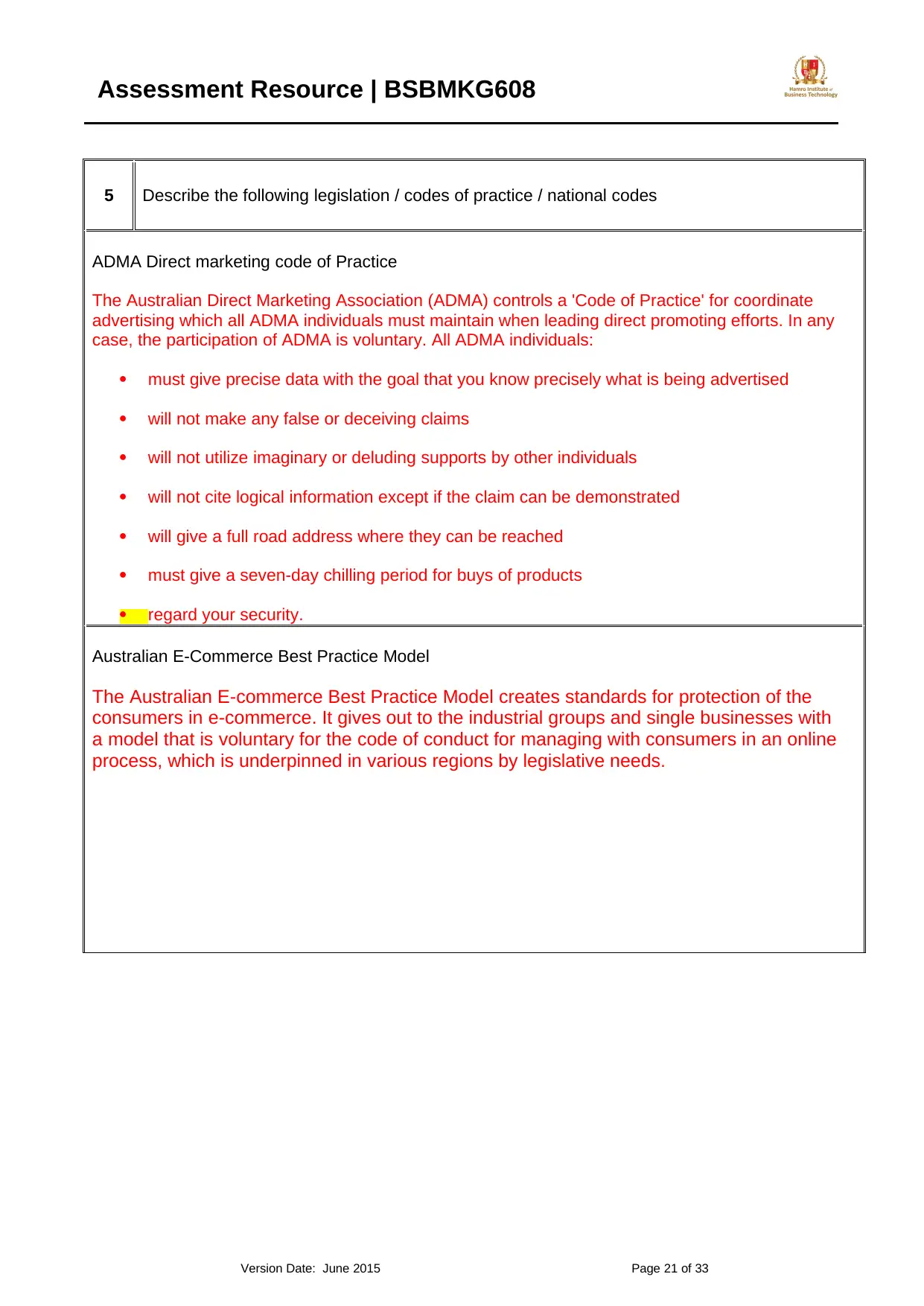
Assessment Resource | BSBMKG608
5 Describe the following legislation / codes of practice / national codes
ADMA Direct marketing code of Practice
The Australian Direct Marketing Association (ADMA) controls a 'Code of Practice' for coordinate
advertising which all ADMA individuals must maintain when leading direct promoting efforts. In any
case, the participation of ADMA is voluntary. All ADMA individuals:
must give precise data with the goal that you know precisely what is being advertised
will not make any false or deceiving claims
will not utilize imaginary or deluding supports by other individuals
will not cite logical information except if the claim can be demonstrated
will give a full road address where they can be reached
must give a seven-day chilling period for buys of products
regard your security.
Australian E-Commerce Best Practice Model
The Australian E-commerce Best Practice Model creates standards for protection of the
consumers in e-commerce. It gives out to the industrial groups and single businesses with
a model that is voluntary for the code of conduct for managing with consumers in an online
process, which is underpinned in various regions by legislative needs.
Version Date: June 2015 Page 21 of 33
5 Describe the following legislation / codes of practice / national codes
ADMA Direct marketing code of Practice
The Australian Direct Marketing Association (ADMA) controls a 'Code of Practice' for coordinate
advertising which all ADMA individuals must maintain when leading direct promoting efforts. In any
case, the participation of ADMA is voluntary. All ADMA individuals:
must give precise data with the goal that you know precisely what is being advertised
will not make any false or deceiving claims
will not utilize imaginary or deluding supports by other individuals
will not cite logical information except if the claim can be demonstrated
will give a full road address where they can be reached
must give a seven-day chilling period for buys of products
regard your security.
Australian E-Commerce Best Practice Model
The Australian E-commerce Best Practice Model creates standards for protection of the
consumers in e-commerce. It gives out to the industrial groups and single businesses with
a model that is voluntary for the code of conduct for managing with consumers in an online
process, which is underpinned in various regions by legislative needs.
Version Date: June 2015 Page 21 of 33

Assessment Resource | BSBMKG608
Australian Government Policy Framework for Consumer Protection in Electronic Commerce
Consumer security is an imperative section to put into thought when building up a promotional plan.
The goal of marketing is to get more customers to expand the business volume. Australian
Government Policy Framework for Consumer Protection in Electronic Commerce is a body that
safeguards the buyers against advertisers who may use misdirecting or false data for the propose of
advertisement. This body additionally guarantees that the items sold to the shoppers are of good
quality. Thus, when building up a promotional plan, it is fundamental to be straightforward when
publicizing.
Free TV Australia Commercial Television Industry Code of Practice
This code of practice looks to control the programs that are associated to the television broadcasting..
the code of practice controls any sort of adult contents, programs ideal for the children and common
advertisements. The code of practice addresses the methods on times to making advertisements in the
televisions, maintain accuracy and fairness, reduce loudness, privacy of the news and the processes
for managing the complaints.
Defamation
This is known to be making false and derogatory statements for the practices of a business in public
and even private and even make false allegations regarding the character, morals, financial status ir
reputation of a business.
Version Date: June 2015 Page 22 of 33
Australian Government Policy Framework for Consumer Protection in Electronic Commerce
Consumer security is an imperative section to put into thought when building up a promotional plan.
The goal of marketing is to get more customers to expand the business volume. Australian
Government Policy Framework for Consumer Protection in Electronic Commerce is a body that
safeguards the buyers against advertisers who may use misdirecting or false data for the propose of
advertisement. This body additionally guarantees that the items sold to the shoppers are of good
quality. Thus, when building up a promotional plan, it is fundamental to be straightforward when
publicizing.
Free TV Australia Commercial Television Industry Code of Practice
This code of practice looks to control the programs that are associated to the television broadcasting..
the code of practice controls any sort of adult contents, programs ideal for the children and common
advertisements. The code of practice addresses the methods on times to making advertisements in the
televisions, maintain accuracy and fairness, reduce loudness, privacy of the news and the processes
for managing the complaints.
Defamation
This is known to be making false and derogatory statements for the practices of a business in public
and even private and even make false allegations regarding the character, morals, financial status ir
reputation of a business.
Version Date: June 2015 Page 22 of 33
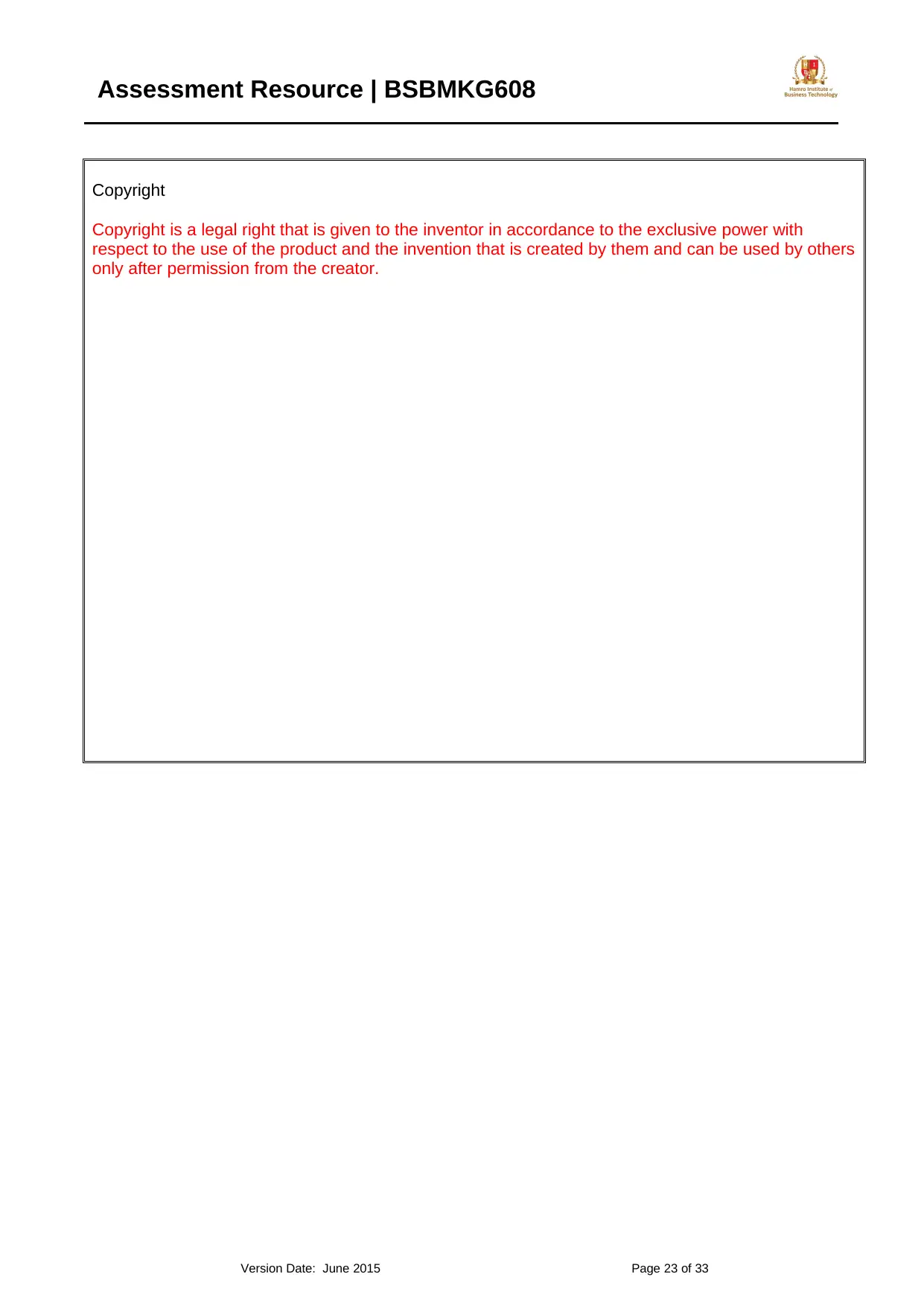
Assessment Resource | BSBMKG608
Copyright
Copyright is a legal right that is given to the inventor in accordance to the exclusive power with
respect to the use of the product and the invention that is created by them and can be used by others
only after permission from the creator.
Version Date: June 2015 Page 23 of 33
Copyright
Copyright is a legal right that is given to the inventor in accordance to the exclusive power with
respect to the use of the product and the invention that is created by them and can be used by others
only after permission from the creator.
Version Date: June 2015 Page 23 of 33
Secure Best Marks with AI Grader
Need help grading? Try our AI Grader for instant feedback on your assignments.

Assessment Resource | BSBMKG608
Equal Opportunity
This is a process that is provided by different regulatory bodies as they provide the power and the
authority to provide equal opportunity to everyone irrespective of their gender class and other mode
of differentiation. This assists everyone with the equal opportunity to possess and make use of any
kind of services and products..
Privacy laws
This refers to the laws that handle with the storing, regulating and usage of any kind of personal
information of a person that can be gathered by the government and other public and private bodies.
In this manner all personal information are safeguarded from the use by any external parties.
Version Date: June 2015 Page 24 of 33
Equal Opportunity
This is a process that is provided by different regulatory bodies as they provide the power and the
authority to provide equal opportunity to everyone irrespective of their gender class and other mode
of differentiation. This assists everyone with the equal opportunity to possess and make use of any
kind of services and products..
Privacy laws
This refers to the laws that handle with the storing, regulating and usage of any kind of personal
information of a person that can be gathered by the government and other public and private bodies.
In this manner all personal information are safeguarded from the use by any external parties.
Version Date: June 2015 Page 24 of 33
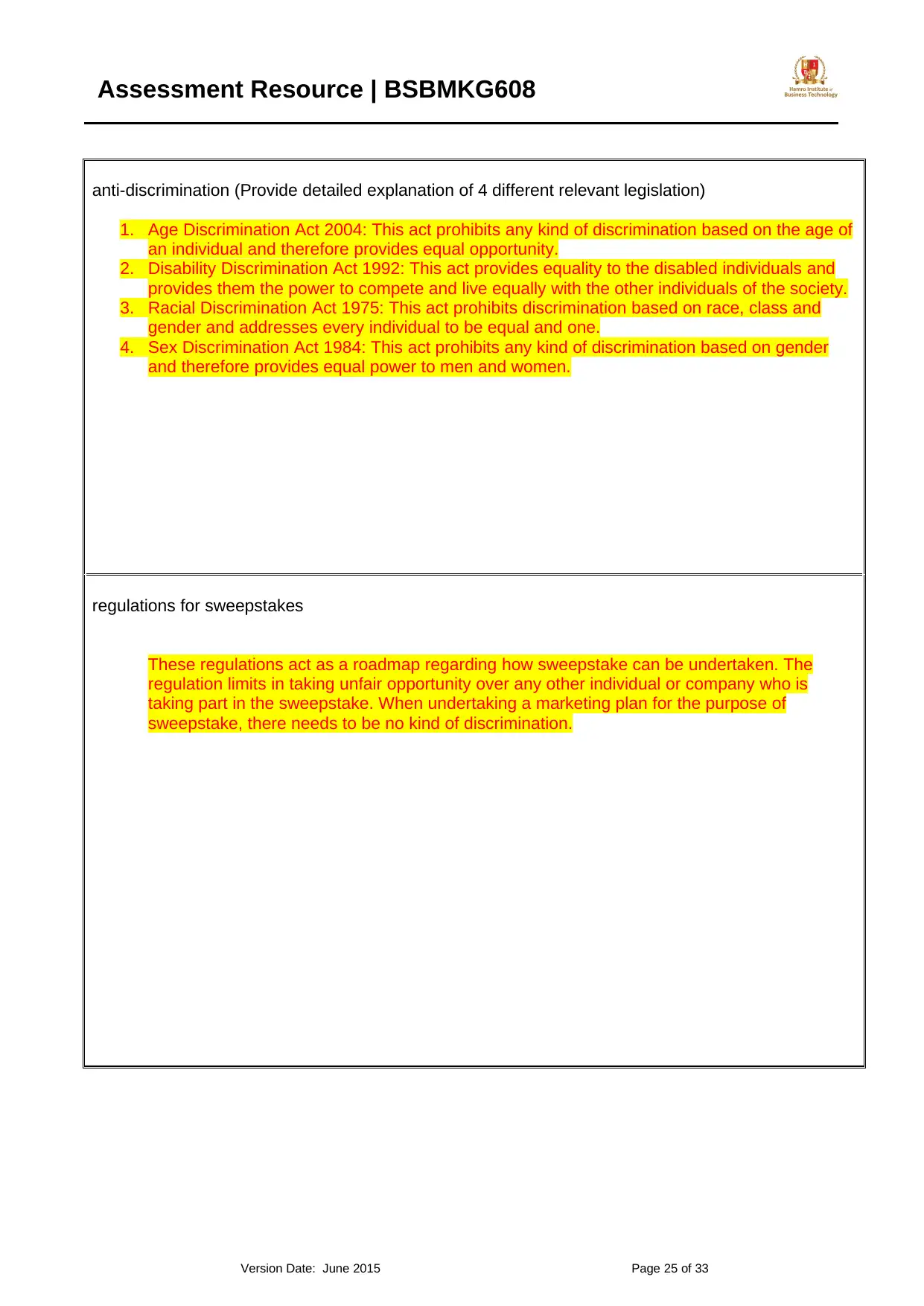
Assessment Resource | BSBMKG608
anti-discrimination (Provide detailed explanation of 4 different relevant legislation)
1. Age Discrimination Act 2004: This act prohibits any kind of discrimination based on the age of
an individual and therefore provides equal opportunity.
2. Disability Discrimination Act 1992: This act provides equality to the disabled individuals and
provides them the power to compete and live equally with the other individuals of the society.
3. Racial Discrimination Act 1975: This act prohibits discrimination based on race, class and
gender and addresses every individual to be equal and one.
4. Sex Discrimination Act 1984: This act prohibits any kind of discrimination based on gender
and therefore provides equal power to men and women.
regulations for sweepstakes
These regulations act as a roadmap regarding how sweepstake can be undertaken. The
regulation limits in taking unfair opportunity over any other individual or company who is
taking part in the sweepstake. When undertaking a marketing plan for the purpose of
sweepstake, there needs to be no kind of discrimination.
Version Date: June 2015 Page 25 of 33
anti-discrimination (Provide detailed explanation of 4 different relevant legislation)
1. Age Discrimination Act 2004: This act prohibits any kind of discrimination based on the age of
an individual and therefore provides equal opportunity.
2. Disability Discrimination Act 1992: This act provides equality to the disabled individuals and
provides them the power to compete and live equally with the other individuals of the society.
3. Racial Discrimination Act 1975: This act prohibits discrimination based on race, class and
gender and addresses every individual to be equal and one.
4. Sex Discrimination Act 1984: This act prohibits any kind of discrimination based on gender
and therefore provides equal power to men and women.
regulations for sweepstakes
These regulations act as a roadmap regarding how sweepstake can be undertaken. The
regulation limits in taking unfair opportunity over any other individual or company who is
taking part in the sweepstake. When undertaking a marketing plan for the purpose of
sweepstake, there needs to be no kind of discrimination.
Version Date: June 2015 Page 25 of 33
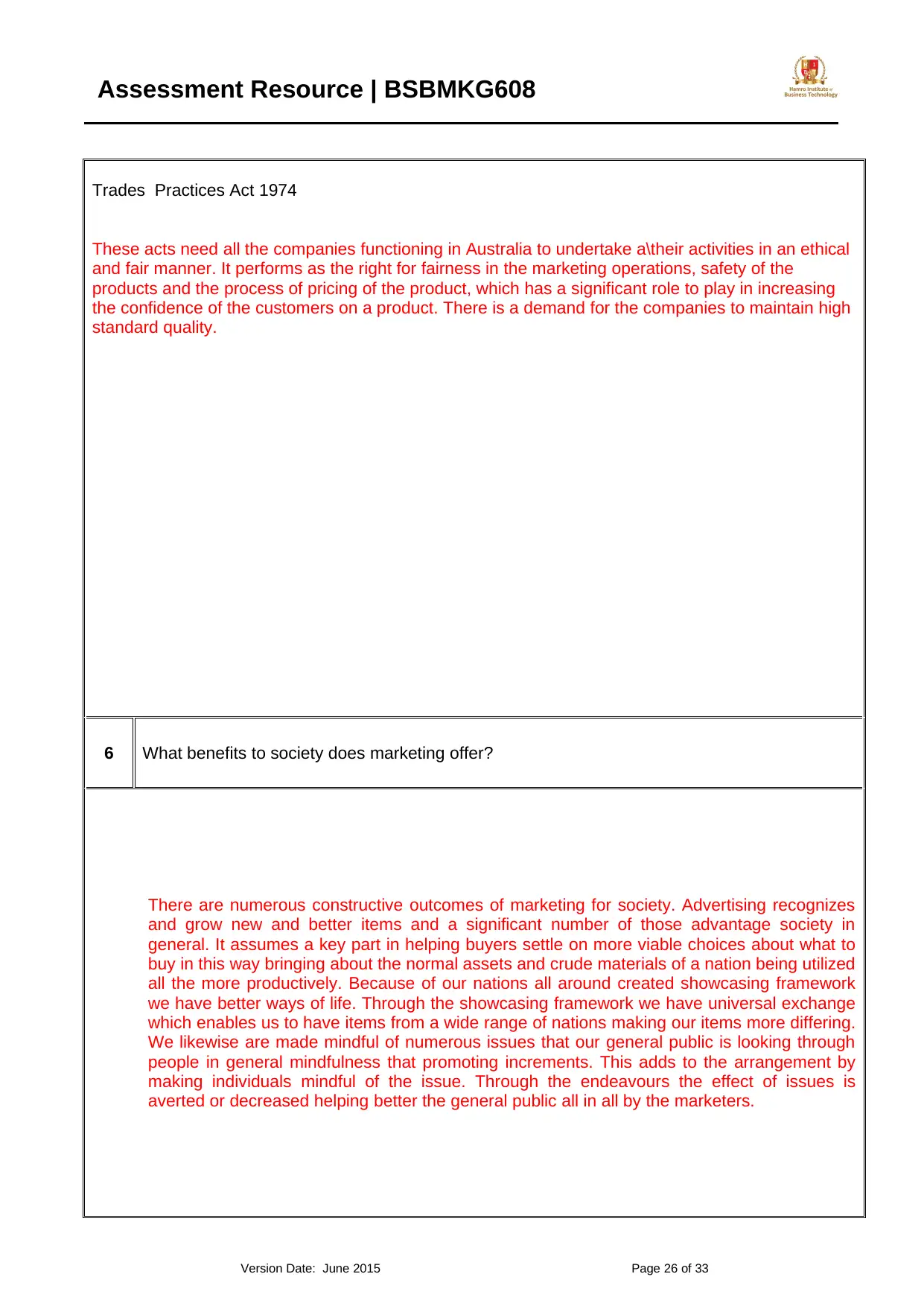
Assessment Resource | BSBMKG608
Trades Practices Act 1974
These acts need all the companies functioning in Australia to undertake a\their activities in an ethical
and fair manner. It performs as the right for fairness in the marketing operations, safety of the
products and the process of pricing of the product, which has a significant role to play in increasing
the confidence of the customers on a product. There is a demand for the companies to maintain high
standard quality.
6 What benefits to society does marketing offer?
There are numerous constructive outcomes of marketing for society. Advertising recognizes
and grow new and better items and a significant number of those advantage society in
general. It assumes a key part in helping buyers settle on more viable choices about what to
buy in this way bringing about the normal assets and crude materials of a nation being utilized
all the more productively. Because of our nations all around created showcasing framework
we have better ways of life. Through the showcasing framework we have universal exchange
which enables us to have items from a wide range of nations making our items more differing.
We likewise are made mindful of numerous issues that our general public is looking through
people in general mindfulness that promoting increments. This adds to the arrangement by
making individuals mindful of the issue. Through the endeavours the effect of issues is
averted or decreased helping better the general public all in all by the marketers.
Version Date: June 2015 Page 26 of 33
Trades Practices Act 1974
These acts need all the companies functioning in Australia to undertake a\their activities in an ethical
and fair manner. It performs as the right for fairness in the marketing operations, safety of the
products and the process of pricing of the product, which has a significant role to play in increasing
the confidence of the customers on a product. There is a demand for the companies to maintain high
standard quality.
6 What benefits to society does marketing offer?
There are numerous constructive outcomes of marketing for society. Advertising recognizes
and grow new and better items and a significant number of those advantage society in
general. It assumes a key part in helping buyers settle on more viable choices about what to
buy in this way bringing about the normal assets and crude materials of a nation being utilized
all the more productively. Because of our nations all around created showcasing framework
we have better ways of life. Through the showcasing framework we have universal exchange
which enables us to have items from a wide range of nations making our items more differing.
We likewise are made mindful of numerous issues that our general public is looking through
people in general mindfulness that promoting increments. This adds to the arrangement by
making individuals mindful of the issue. Through the endeavours the effect of issues is
averted or decreased helping better the general public all in all by the marketers.
Version Date: June 2015 Page 26 of 33
Paraphrase This Document
Need a fresh take? Get an instant paraphrase of this document with our AI Paraphraser
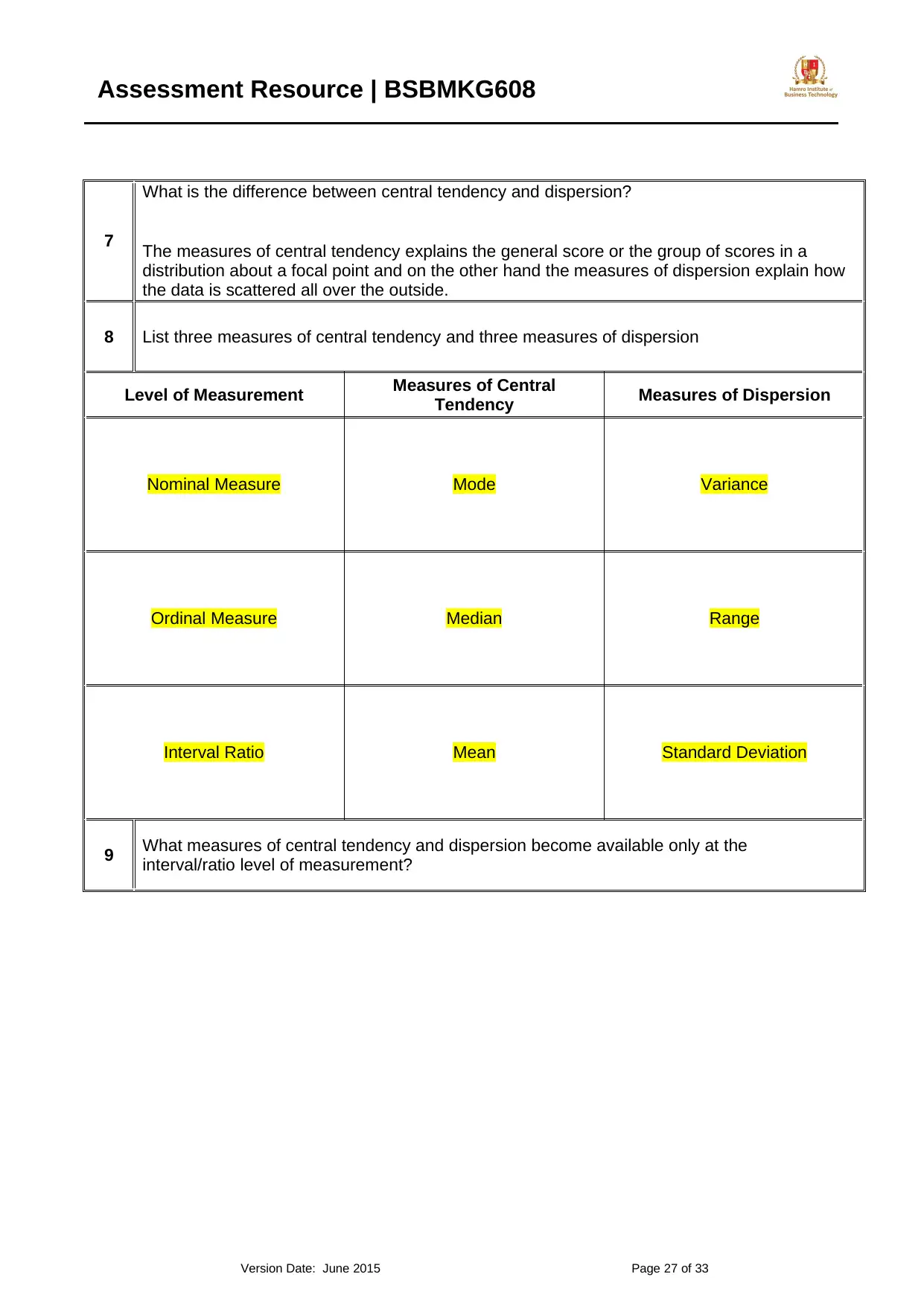
Assessment Resource | BSBMKG608
7
What is the difference between central tendency and dispersion?
The measures of central tendency explains the general score or the group of scores in a
distribution about a focal point and on the other hand the measures of dispersion explain how
the data is scattered all over the outside.
8 List three measures of central tendency and three measures of dispersion
Level of Measurement Measures of Central
Tendency Measures of Dispersion
Nominal Measure Mode Variance
Ordinal Measure Median Range
Interval Ratio Mean Standard Deviation
9 What measures of central tendency and dispersion become available only at the
interval/ratio level of measurement?
Version Date: June 2015 Page 27 of 33
7
What is the difference between central tendency and dispersion?
The measures of central tendency explains the general score or the group of scores in a
distribution about a focal point and on the other hand the measures of dispersion explain how
the data is scattered all over the outside.
8 List three measures of central tendency and three measures of dispersion
Level of Measurement Measures of Central
Tendency Measures of Dispersion
Nominal Measure Mode Variance
Ordinal Measure Median Range
Interval Ratio Mean Standard Deviation
9 What measures of central tendency and dispersion become available only at the
interval/ratio level of measurement?
Version Date: June 2015 Page 27 of 33
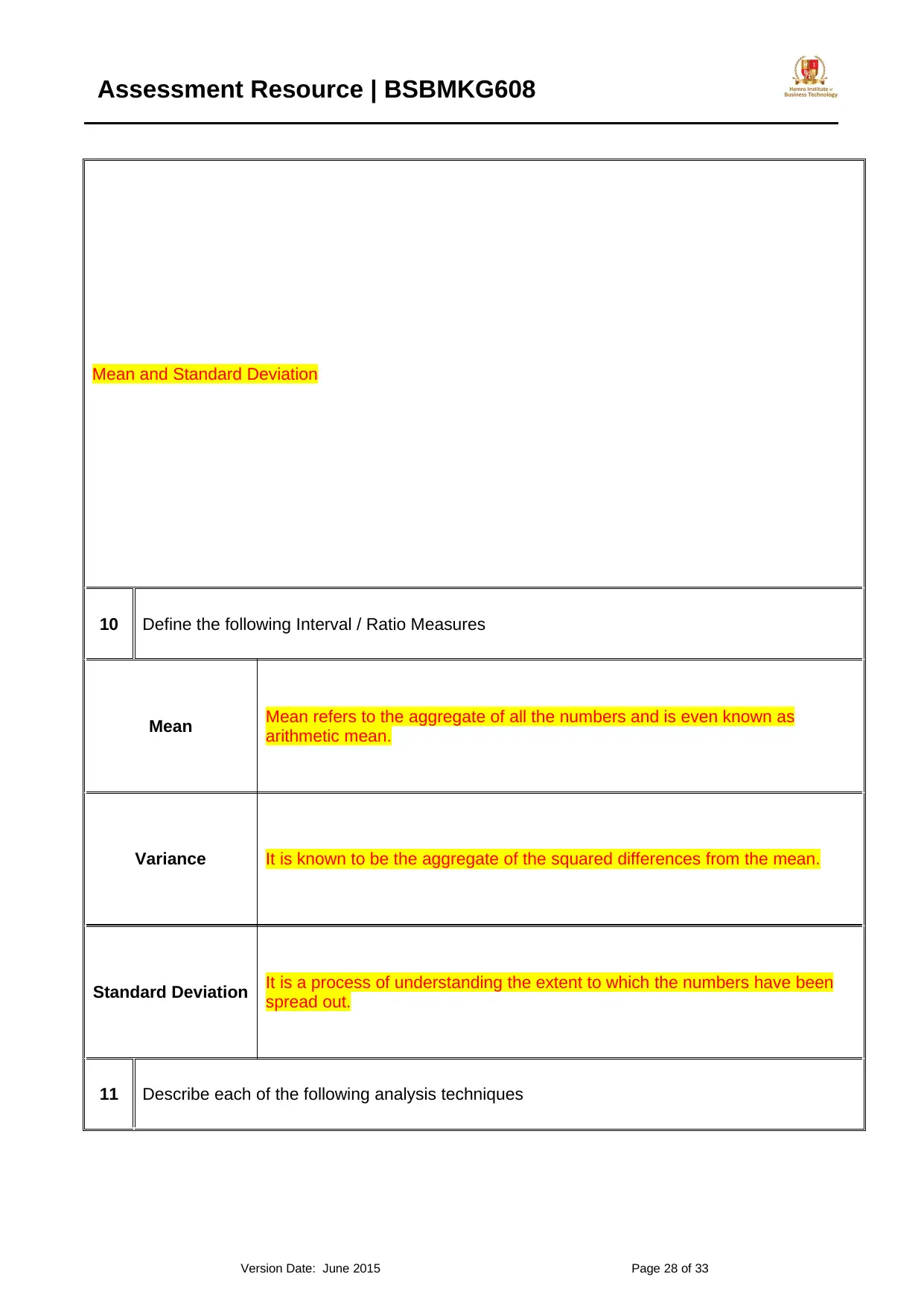
Assessment Resource | BSBMKG608
Mean and Standard Deviation
10 Define the following Interval / Ratio Measures
Mean Mean refers to the aggregate of all the numbers and is even known as
arithmetic mean.
Variance It is known to be the aggregate of the squared differences from the mean.
Standard Deviation It is a process of understanding the extent to which the numbers have been
spread out.
11 Describe each of the following analysis techniques
Version Date: June 2015 Page 28 of 33
Mean and Standard Deviation
10 Define the following Interval / Ratio Measures
Mean Mean refers to the aggregate of all the numbers and is even known as
arithmetic mean.
Variance It is known to be the aggregate of the squared differences from the mean.
Standard Deviation It is a process of understanding the extent to which the numbers have been
spread out.
11 Describe each of the following analysis techniques
Version Date: June 2015 Page 28 of 33
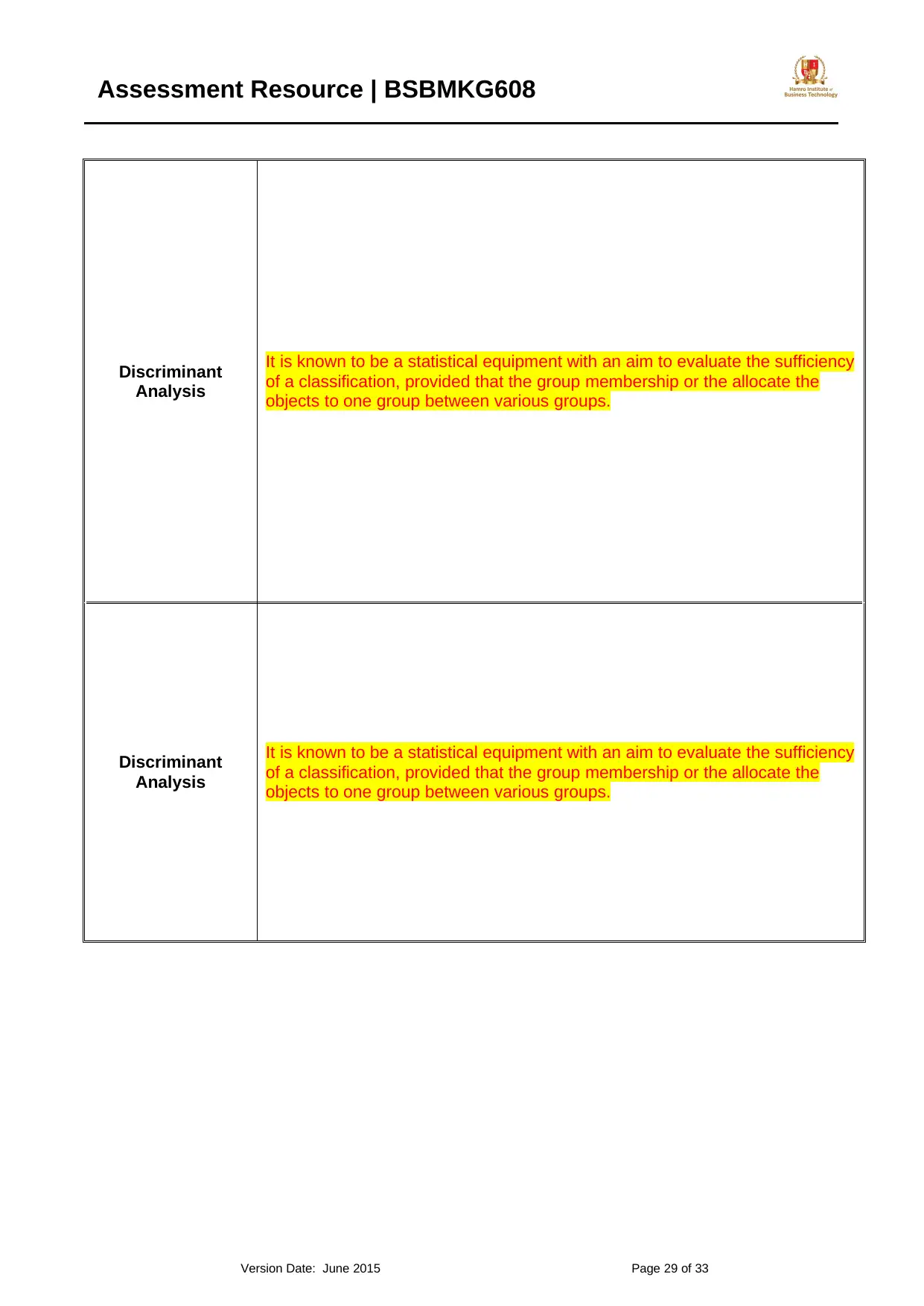
Assessment Resource | BSBMKG608
Discriminant
Analysis
It is known to be a statistical equipment with an aim to evaluate the sufficiency
of a classification, provided that the group membership or the allocate the
objects to one group between various groups.
Discriminant
Analysis
It is known to be a statistical equipment with an aim to evaluate the sufficiency
of a classification, provided that the group membership or the allocate the
objects to one group between various groups.
Version Date: June 2015 Page 29 of 33
Discriminant
Analysis
It is known to be a statistical equipment with an aim to evaluate the sufficiency
of a classification, provided that the group membership or the allocate the
objects to one group between various groups.
Discriminant
Analysis
It is known to be a statistical equipment with an aim to evaluate the sufficiency
of a classification, provided that the group membership or the allocate the
objects to one group between various groups.
Version Date: June 2015 Page 29 of 33
Secure Best Marks with AI Grader
Need help grading? Try our AI Grader for instant feedback on your assignments.
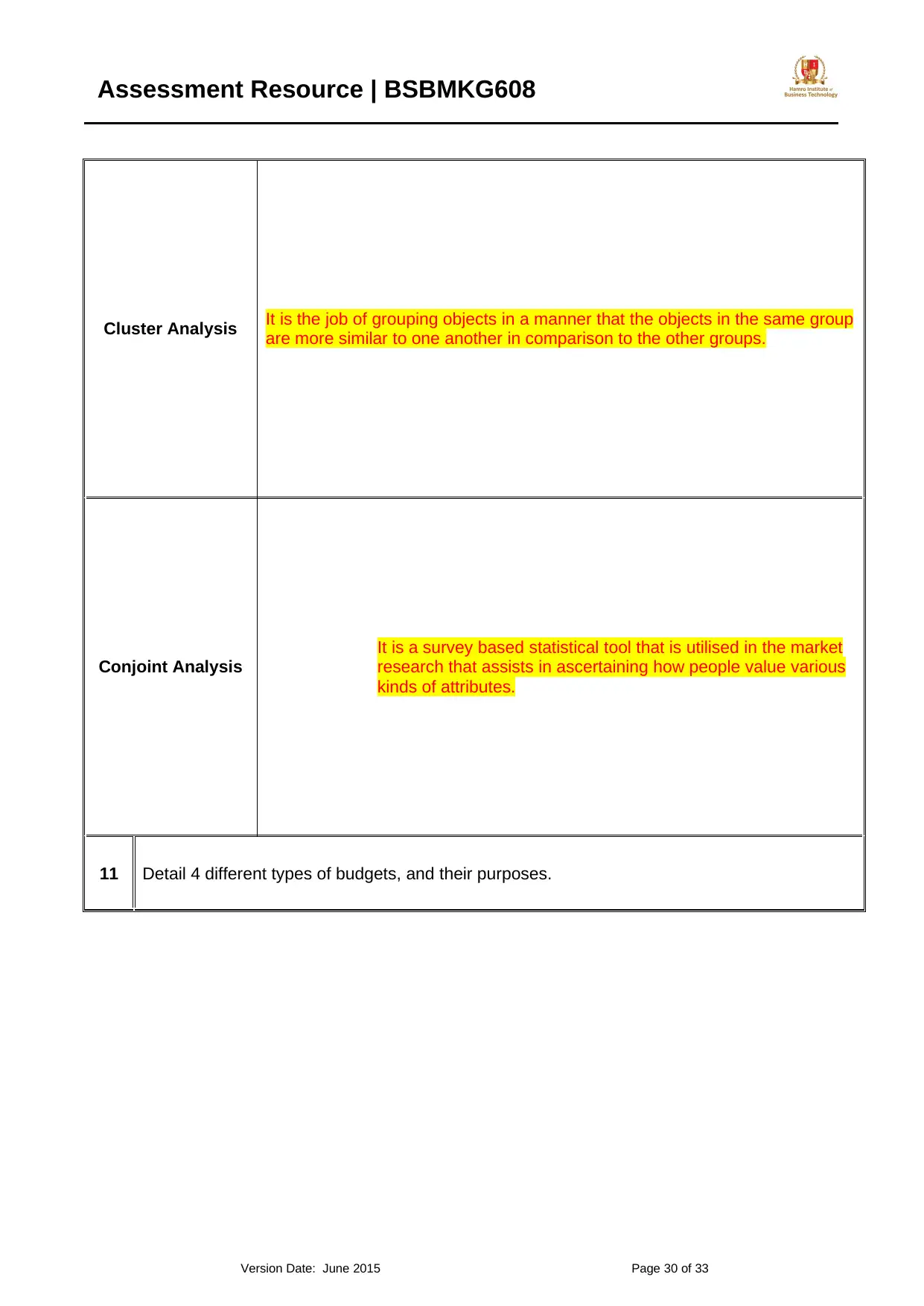
Assessment Resource | BSBMKG608
Cluster Analysis It is the job of grouping objects in a manner that the objects in the same group
are more similar to one another in comparison to the other groups.
Conjoint Analysis
It is a survey based statistical tool that is utilised in the market
research that assists in ascertaining how people value various
kinds of attributes.
11 Detail 4 different types of budgets, and their purposes.
Version Date: June 2015 Page 30 of 33
Cluster Analysis It is the job of grouping objects in a manner that the objects in the same group
are more similar to one another in comparison to the other groups.
Conjoint Analysis
It is a survey based statistical tool that is utilised in the market
research that assists in ascertaining how people value various
kinds of attributes.
11 Detail 4 different types of budgets, and their purposes.
Version Date: June 2015 Page 30 of 33
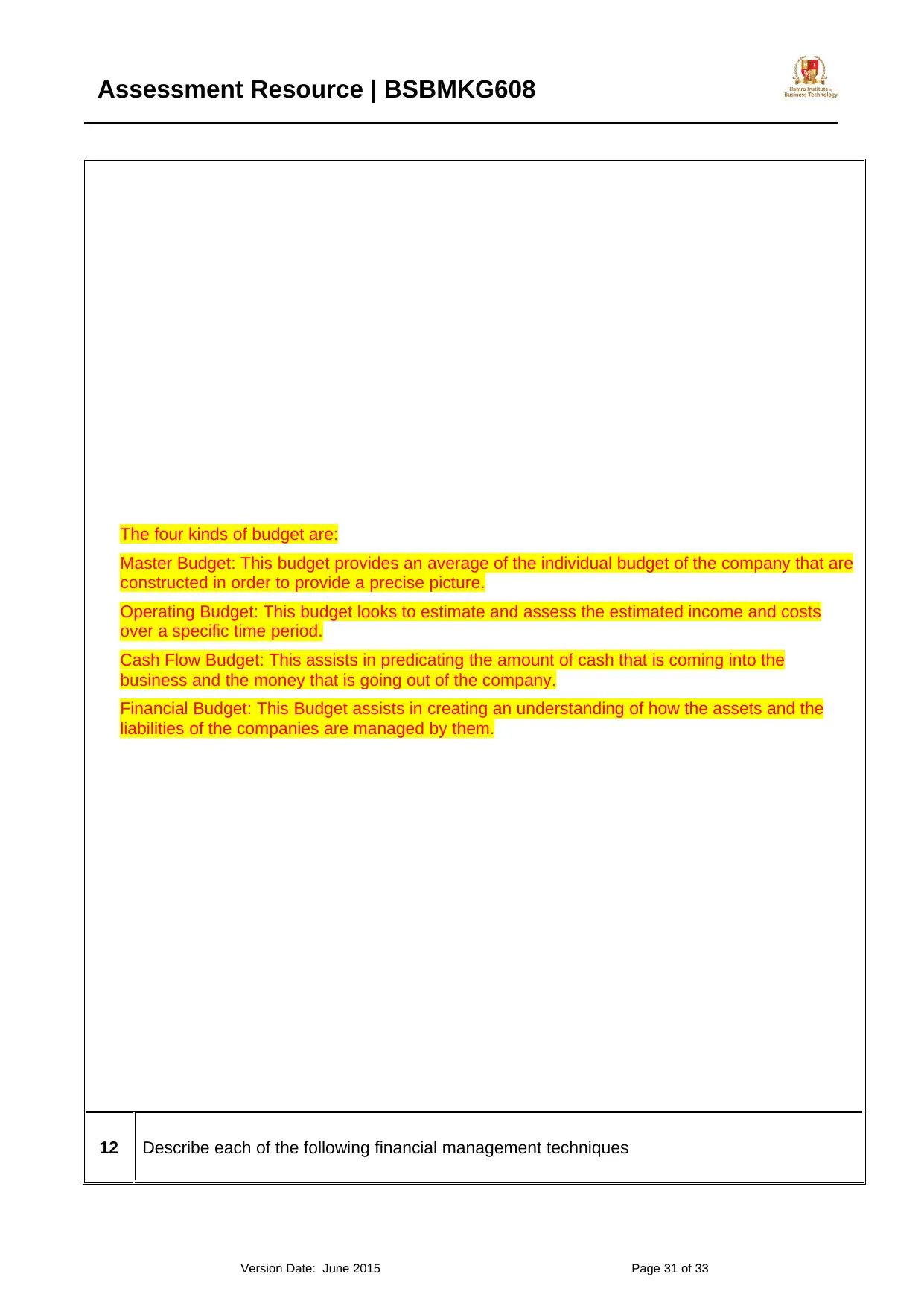
Assessment Resource | BSBMKG608
The four kinds of budget are:
Master Budget: This budget provides an average of the individual budget of the company that are
constructed in order to provide a precise picture.
Operating Budget: This budget looks to estimate and assess the estimated income and costs
over a specific time period.
Cash Flow Budget: This assists in predicating the amount of cash that is coming into the
business and the money that is going out of the company.
Financial Budget: This Budget assists in creating an understanding of how the assets and the
liabilities of the companies are managed by them.
12 Describe each of the following financial management techniques
Version Date: June 2015 Page 31 of 33
The four kinds of budget are:
Master Budget: This budget provides an average of the individual budget of the company that are
constructed in order to provide a precise picture.
Operating Budget: This budget looks to estimate and assess the estimated income and costs
over a specific time period.
Cash Flow Budget: This assists in predicating the amount of cash that is coming into the
business and the money that is going out of the company.
Financial Budget: This Budget assists in creating an understanding of how the assets and the
liabilities of the companies are managed by them.
12 Describe each of the following financial management techniques
Version Date: June 2015 Page 31 of 33
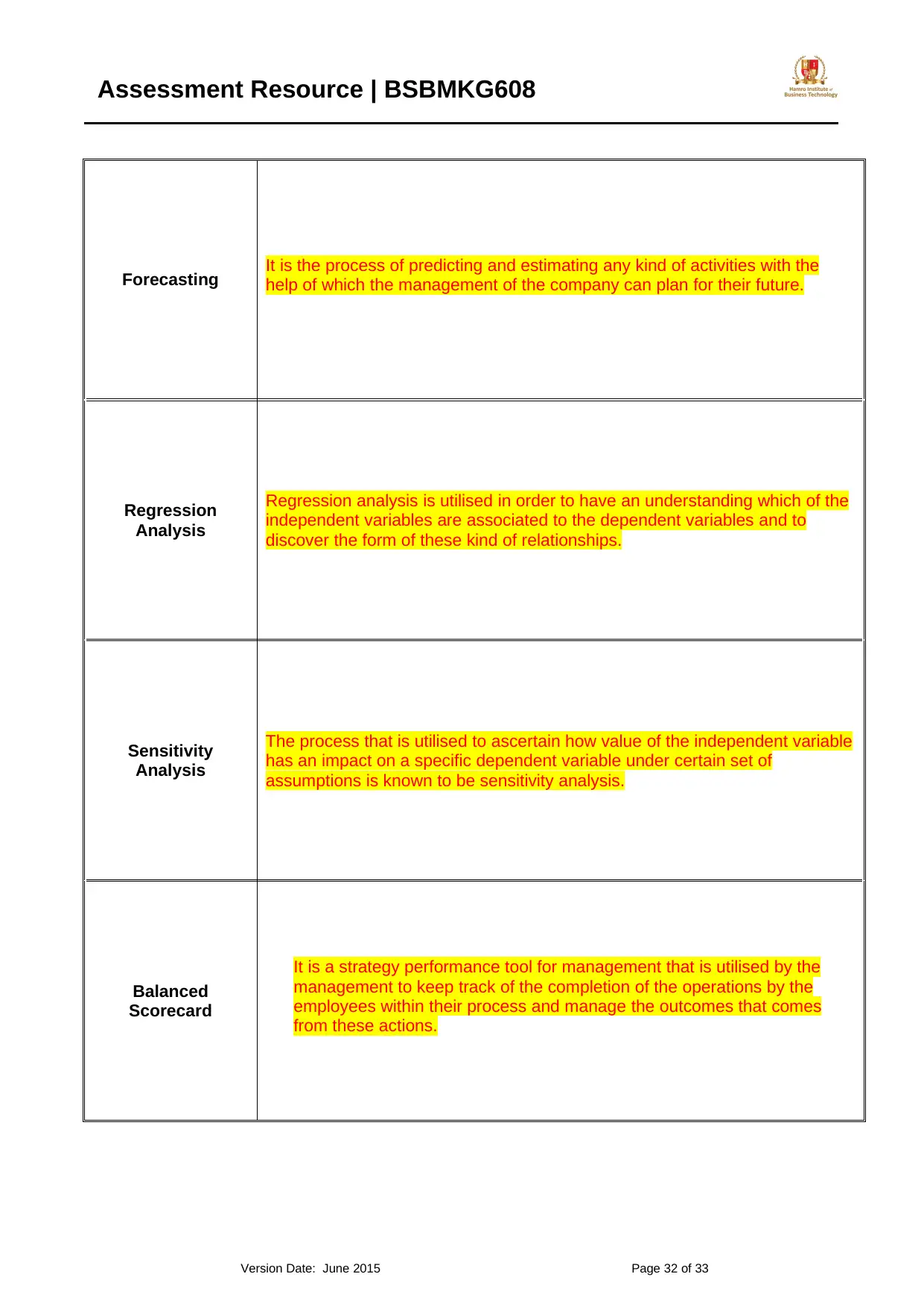
Assessment Resource | BSBMKG608
Forecasting It is the process of predicting and estimating any kind of activities with the
help of which the management of the company can plan for their future.
Regression
Analysis
Regression analysis is utilised in order to have an understanding which of the
independent variables are associated to the dependent variables and to
discover the form of these kind of relationships.
Sensitivity
Analysis
The process that is utilised to ascertain how value of the independent variable
has an impact on a specific dependent variable under certain set of
assumptions is known to be sensitivity analysis.
Balanced
Scorecard
It is a strategy performance tool for management that is utilised by the
management to keep track of the completion of the operations by the
employees within their process and manage the outcomes that comes
from these actions.
Version Date: June 2015 Page 32 of 33
Forecasting It is the process of predicting and estimating any kind of activities with the
help of which the management of the company can plan for their future.
Regression
Analysis
Regression analysis is utilised in order to have an understanding which of the
independent variables are associated to the dependent variables and to
discover the form of these kind of relationships.
Sensitivity
Analysis
The process that is utilised to ascertain how value of the independent variable
has an impact on a specific dependent variable under certain set of
assumptions is known to be sensitivity analysis.
Balanced
Scorecard
It is a strategy performance tool for management that is utilised by the
management to keep track of the completion of the operations by the
employees within their process and manage the outcomes that comes
from these actions.
Version Date: June 2015 Page 32 of 33
Paraphrase This Document
Need a fresh take? Get an instant paraphrase of this document with our AI Paraphraser

Assessment Resource | BSBMKG608
Performance
Reporting
This is the process of disseminating and gathering the information related to
the project with the help of which the progress of the project is communicated
and the efficiency level of the activities are reported.
Student Declaration: I declare that the work
submitted is my own, and has not been copied or
plagiarised from any person or source.
Name: ____Sandip Panthi_______________
Signature: _____Sandip___________
Date: ____/_____/_____
ASSESSOR USE ONLY
Comments
Assessment Method: WRITTEN / PROJECT
Result
(Please Circle) Satisfactory Not Satisfactory Incomplete
Assessor: I declare that I have conducted a fair, valid,
reliable and flexible assessment with this student, and I have
provided appropriate feedback
Name: ________________________
Signature:
________________________
Date: ____/_____/_____
Version Date: June 2015 Page 33 of 33
Performance
Reporting
This is the process of disseminating and gathering the information related to
the project with the help of which the progress of the project is communicated
and the efficiency level of the activities are reported.
Student Declaration: I declare that the work
submitted is my own, and has not been copied or
plagiarised from any person or source.
Name: ____Sandip Panthi_______________
Signature: _____Sandip___________
Date: ____/_____/_____
ASSESSOR USE ONLY
Comments
Assessment Method: WRITTEN / PROJECT
Result
(Please Circle) Satisfactory Not Satisfactory Incomplete
Assessor: I declare that I have conducted a fair, valid,
reliable and flexible assessment with this student, and I have
provided appropriate feedback
Name: ________________________
Signature:
________________________
Date: ____/_____/_____
Version Date: June 2015 Page 33 of 33
1 out of 32
Related Documents
Your All-in-One AI-Powered Toolkit for Academic Success.
+13062052269
info@desklib.com
Available 24*7 on WhatsApp / Email
![[object Object]](/_next/static/media/star-bottom.7253800d.svg)
Unlock your academic potential
© 2024 | Zucol Services PVT LTD | All rights reserved.




